It was a wonderful mini-break in a rented house with a swimming pool in the area that belongs to greater Belgrade. What I want to say is that it was very close to home and yet far enough to constitute a proper small vacation. Although I don’t think I had too much work this summer, I really enjoyed going somewhere out of my home and not dealing with my daily tasks no matter how much I enjoyed some of them.
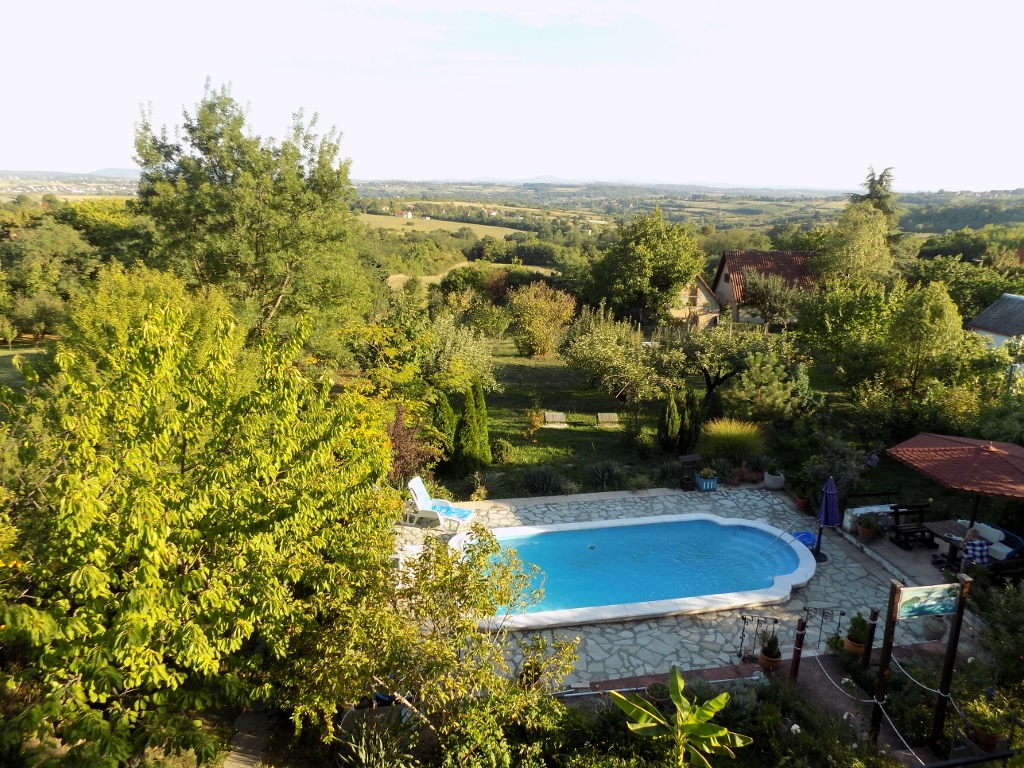 Room with a view during the mini break
Room with a view during the mini break

This mini break was additionally great because I was with my beloved cousin Svetlana. Although the weather was not ideal for swimming, we still enjoyed a great deal, chatting and relaxing.
Once the “vacation” was over, on our way home we went for the sightseeing of some interesting sites that exist in this area. I had envisaged the route in such a way that we started in village Baćevac and here is also a map that shows all the places we went to. When one leaves from the centre of Belgrade, the length of the covered route is around 130 km.
First we went to visit the Church of the Holy Trinity in Baćevac which is a monument of culture. We got off the main road and left the car on a side clearing. While walking towards the nearby churchyard I noticed on the right-hand side, on a small elevation, a monument. It seemed a little odd since it looked like a tombstone, but there was no graveyard there, so I went closer. There was a grave indeed, but just like that, on its own, left to the time and almost like accidentally being there. Here is what it says on the side I took the following photo of: “The Serbian soldier perished gloriously for the homeland in 1915 – the monument erected by grateful inhabitants of Baćevac.”
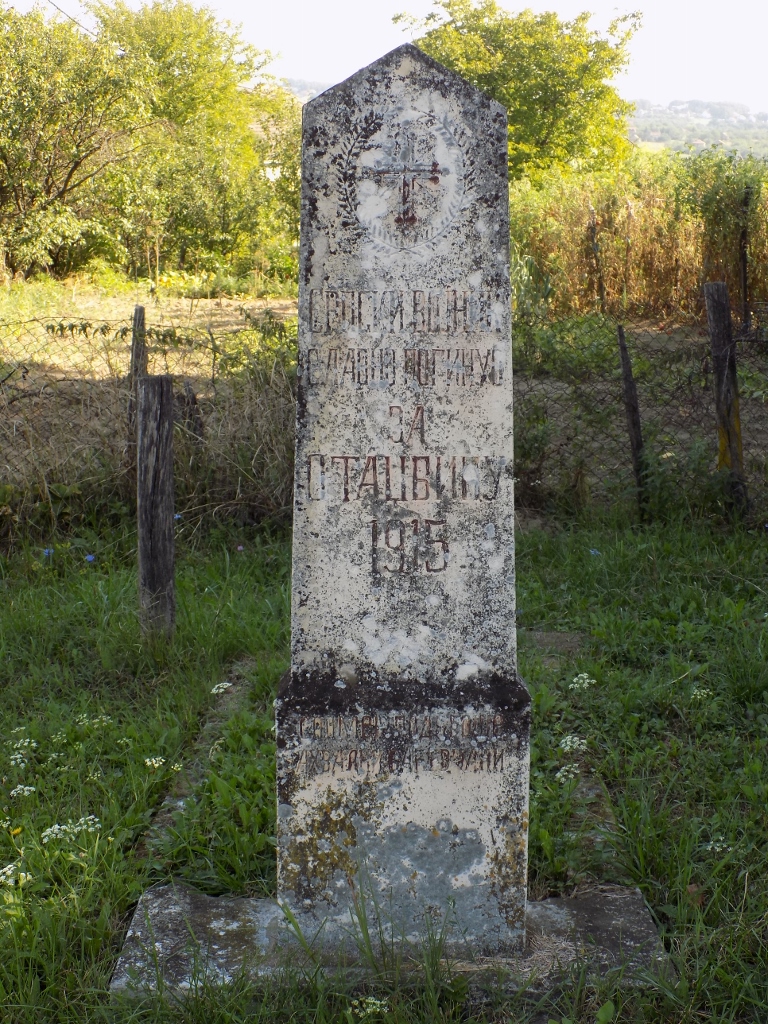 Monument to the Serbian soldier killed in 1915
Monument to the Serbian soldier killed in 1915
So, a few dozen metres farther from this tombstone there is the entrance into the yard of the Church of the Holy Trinity in Baćevac.
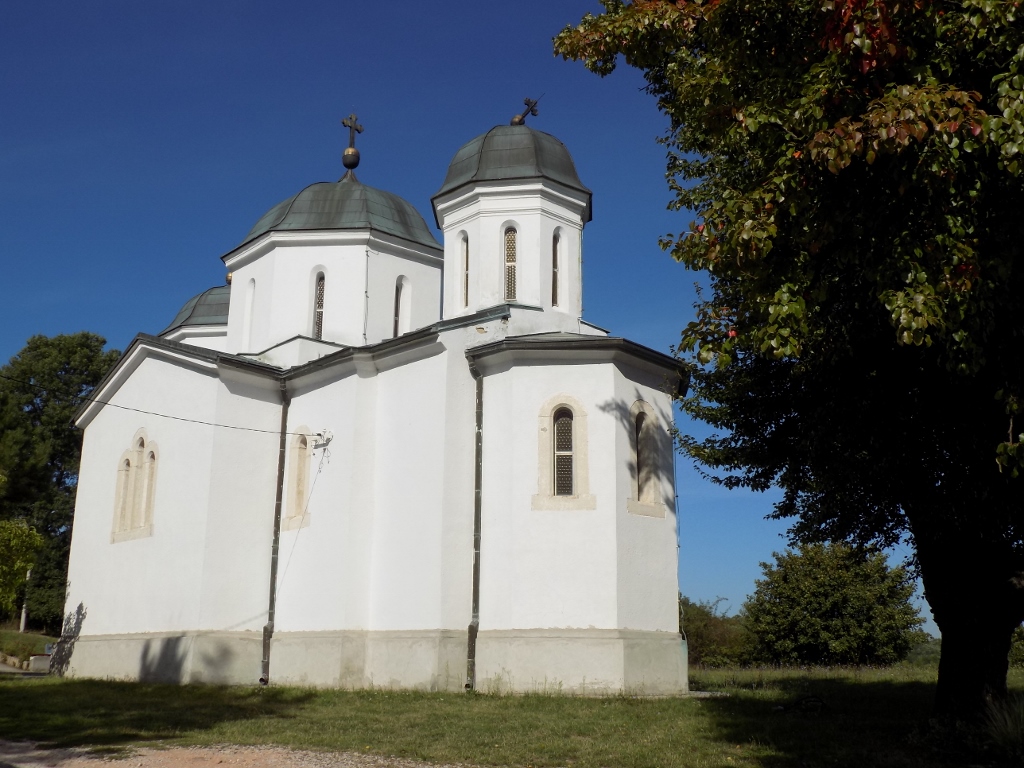 Church of the Holy Trinity in Baćevac
Church of the Holy Trinity in Baćevac
The church was built in 1882 near the place where there used to be a wooden church from the first half of the 19th century. By its architectural elements this church constitutes an early example of the renewed Serbian-Byzantine style from the second half of the 19th century. This is a single-nave building and what is a little unusual is that it has three domes, above the narthex, above the central bay of the naos and above the altar space, which in facts accentuates its dedication to the Holy Trinity.
The white colour of the facade continues inside as well, which perhaps helps the 19th century iconostasis and its icons from 1914 stand out even more.
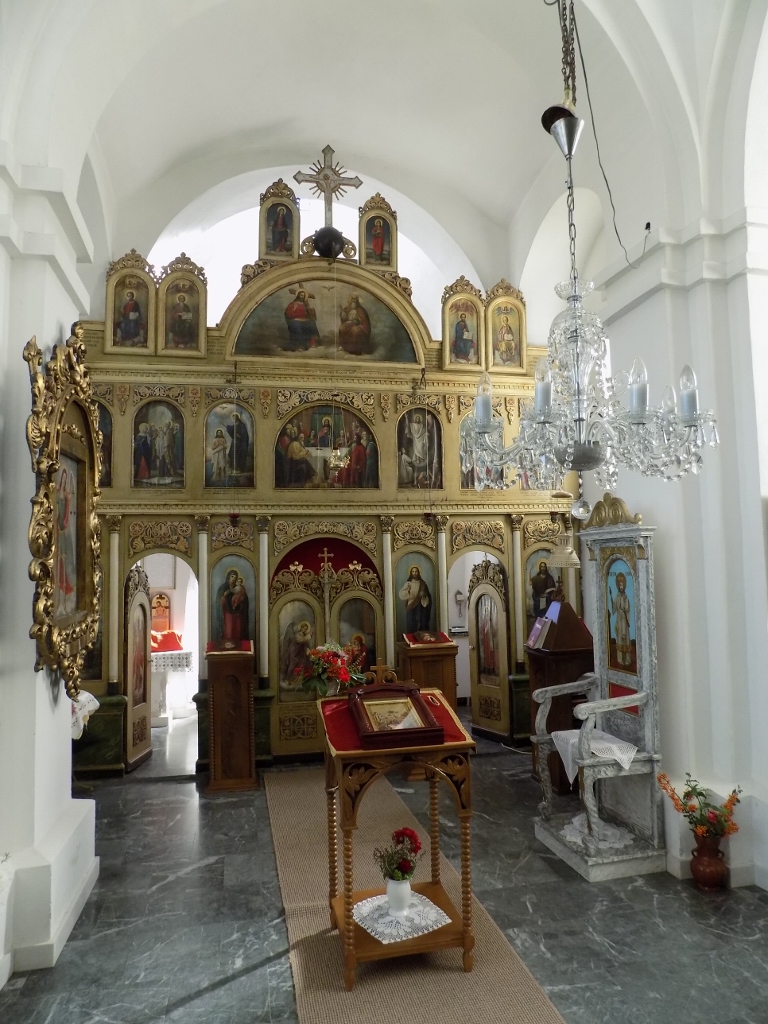 Church of the Holy Trinity in Baćevac, the iconostasis
Church of the Holy Trinity in Baćevac, the iconostasis
What I found particularly interesting about the icons is that beside each one of them it is written who gave the donation and for whose soul they were made and placed here.
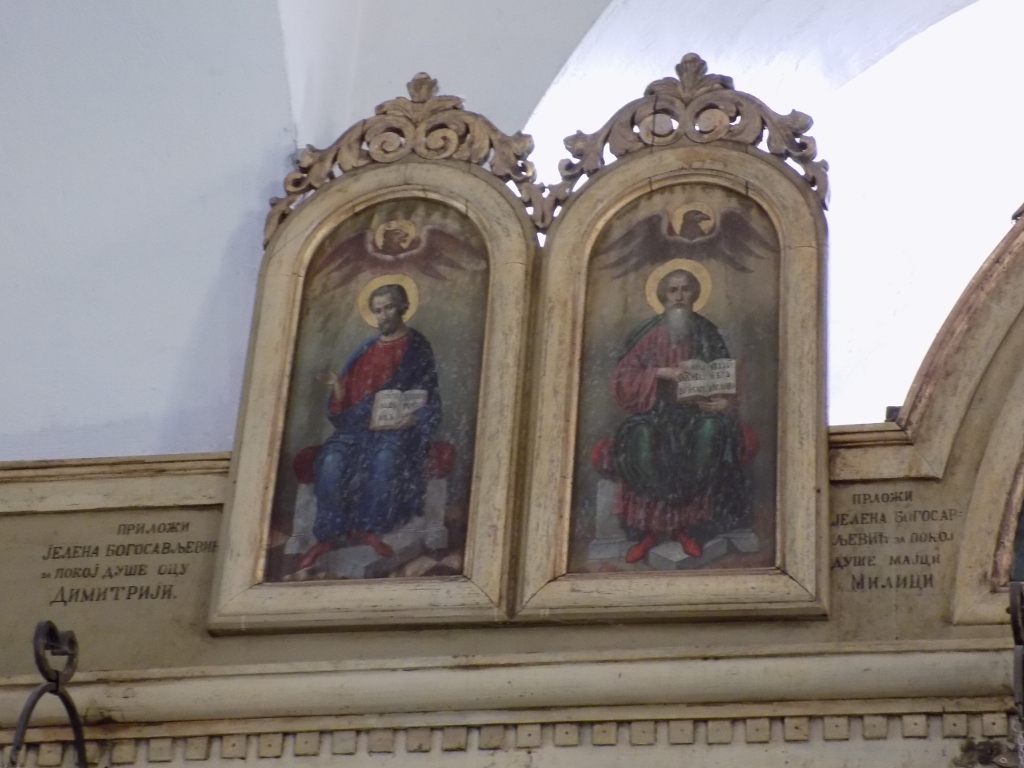 Church of the Holy Trinity in Baćevac, a part of the iconostasis
Church of the Holy Trinity in Baćevac, a part of the iconostasis
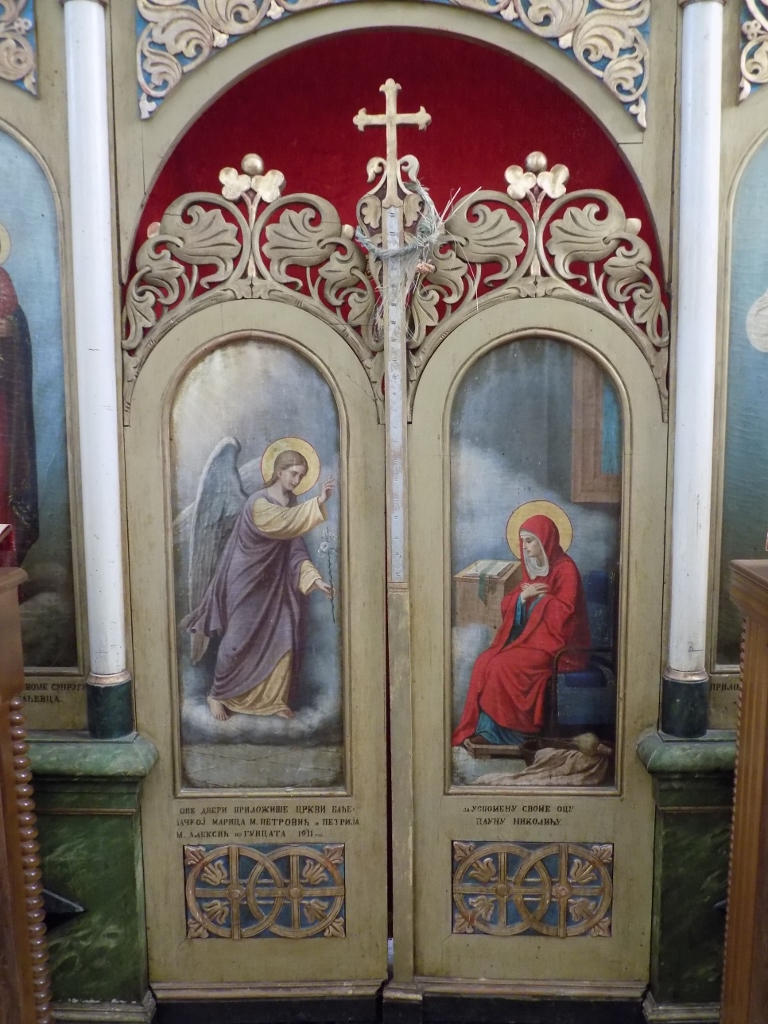 Church of the Holy Trinity in Baćevac, the royal doors
Church of the Holy Trinity in Baćevac, the royal doors
Then Svetlana and I walked a little around the churchyard since there were several tombstones there. For instance, one from 1899 which says nicely that it was “put [there] at the expense of the church.”
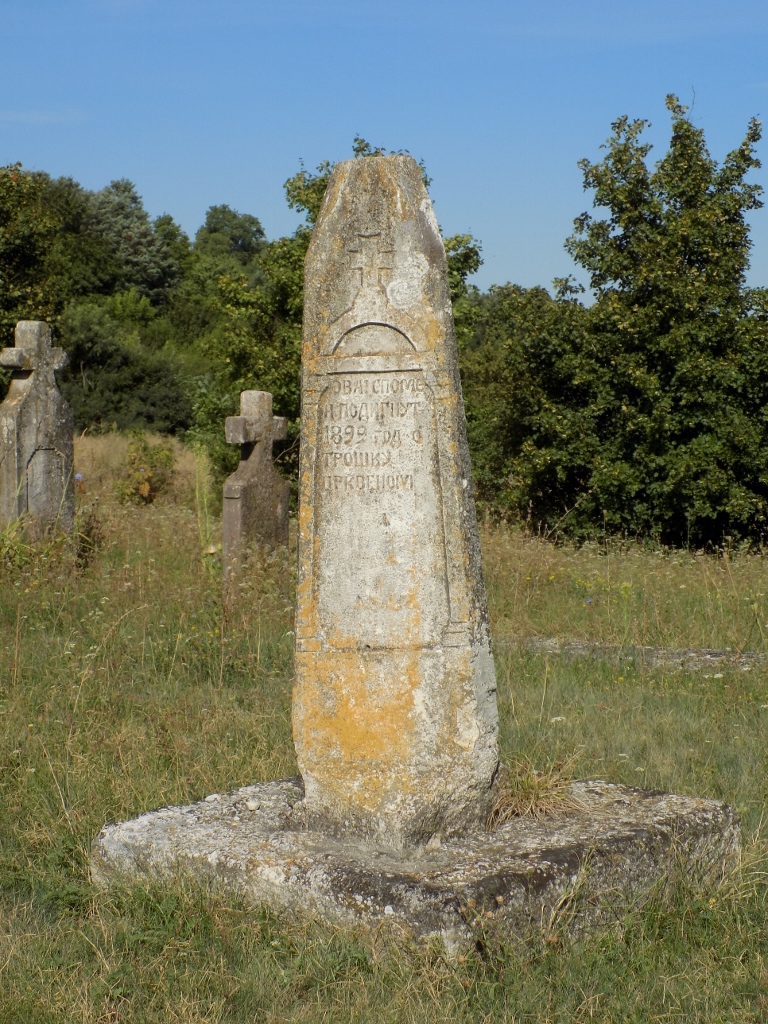 A 1899 tombstone
A 1899 tombstone
What started to become very clear was that a lot of men from the village perished during the two Balkan Wars (1912-1913) and during WWI (1914-1918). A monument that stands out from the bunch, being made of granite, is dedicated precisely to them and it has an unusual segment made of an ordinary rock.
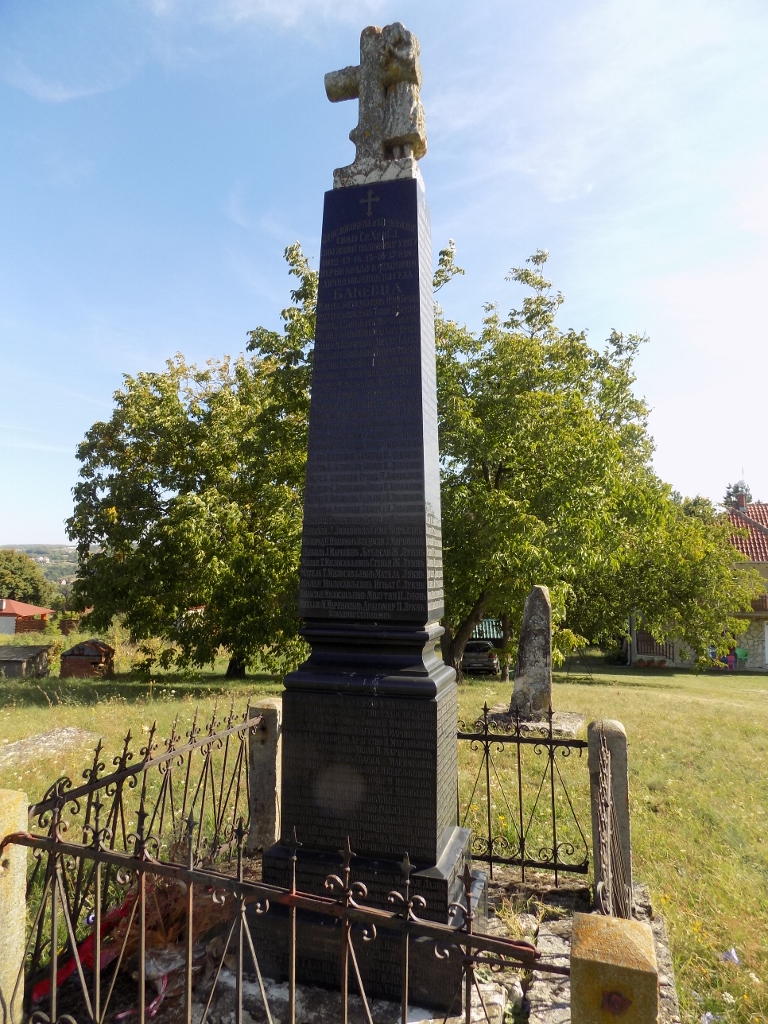 Monument to the soldiers perished in the period 1912-1918
Monument to the soldiers perished in the period 1912-1918
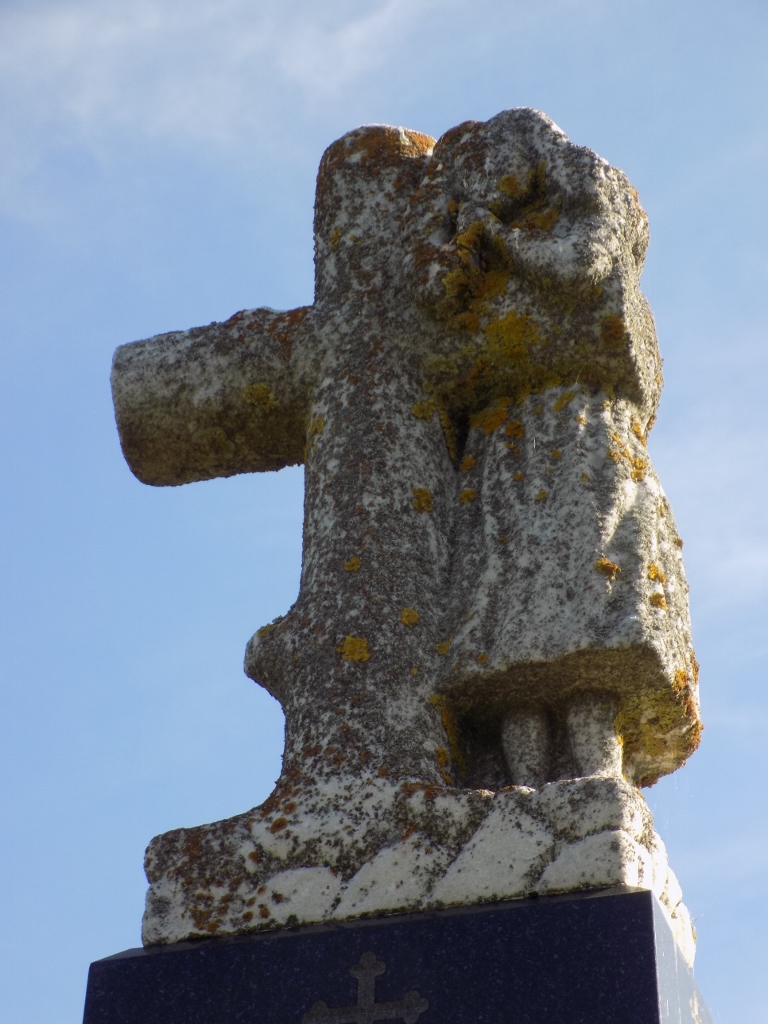 The unusual decoration on the top of the monument
The unusual decoration on the top of the monument
However, bearing in mind the events from the end of the 20th century and the national sentiments that permeate well through the 21st century, even more unusual is the inscription on the monument: “For the liberation and unification of all Serbs, Croats and Slovenes, those who gave their lives were...“
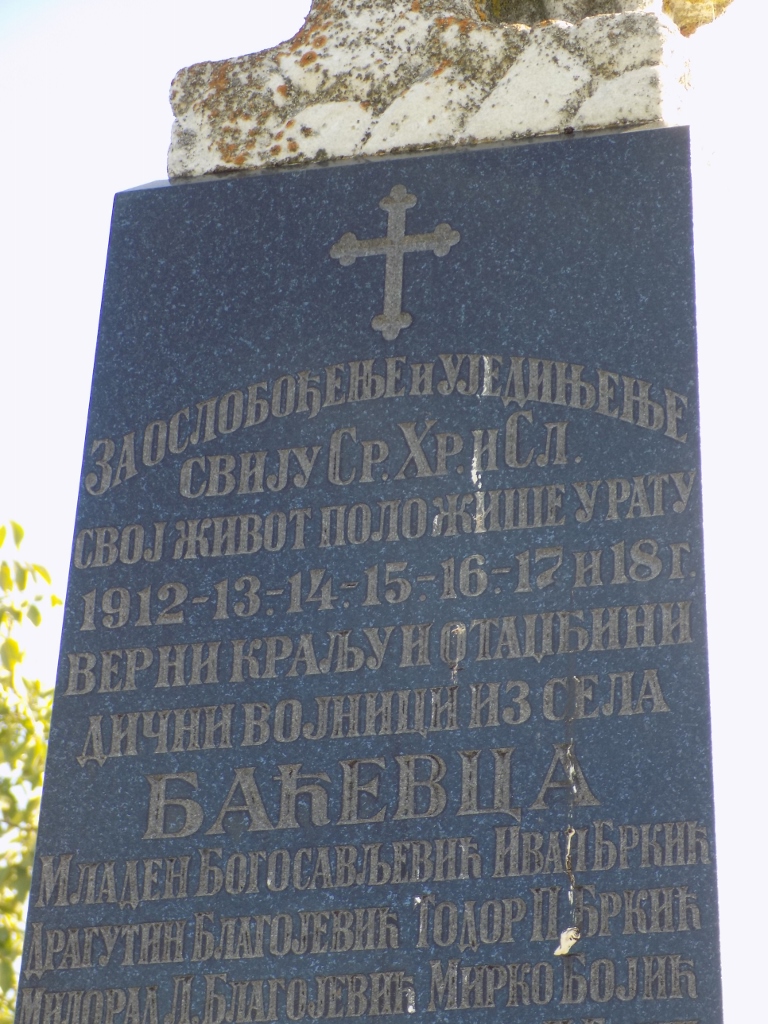 Inscription on the monument in the yard of the Church of the Holy Trinity in Baćevac
Inscription on the monument in the yard of the Church of the Holy Trinity in Baćevac
There are more tombstones in the churchyard and several of them have been moved and placed on the purpose-made concrete slab. The monuments were made for a very sad cause, but I was truly impressed by their beautiful appearance, as well as the fact that they are carefully kept.
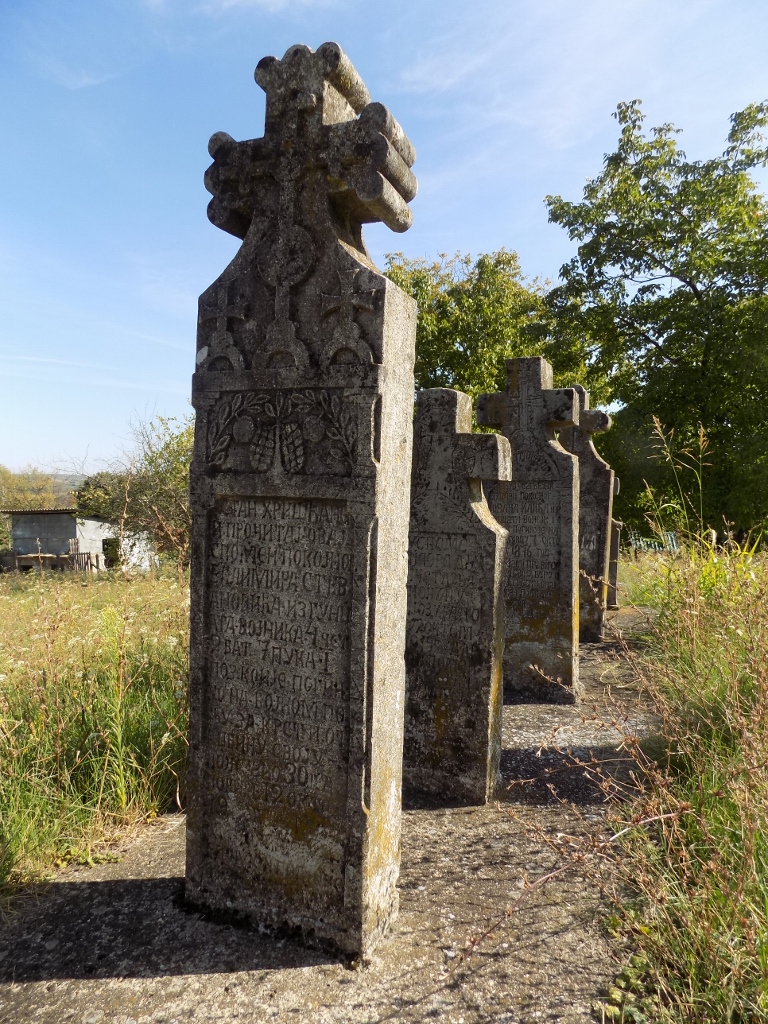 Grouped-up tombstones
Grouped-up tombstones
Following the visit to the church, we went for a short walk and from one place we had a lovely view at the surroundings of Baćevac village.

Then we got into the car and drove to the centre of Barajevo which is one of the municipalities of the City of Belgrade. In the very centre there is the Stara mehana (Old Inn), a monument of culture, built in the first half of the 19th century.
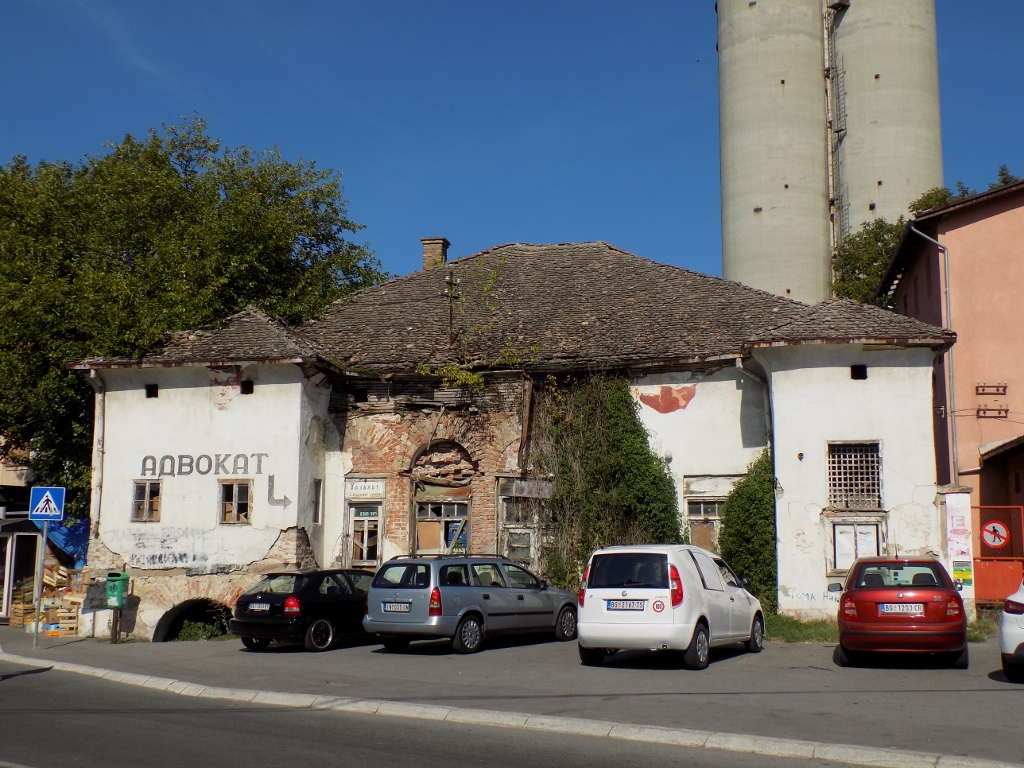 Stara mehana in Barajevo
Stara mehana in Barajevo
Although this structure represents a typical example of a Serbian road inn from the 19th century, having been built right by the old road (nowadays the main street in this town), and although it is located in the very centre (some 50 m from the Municipality of Barajevo), it is obviously in a very crumbly state.
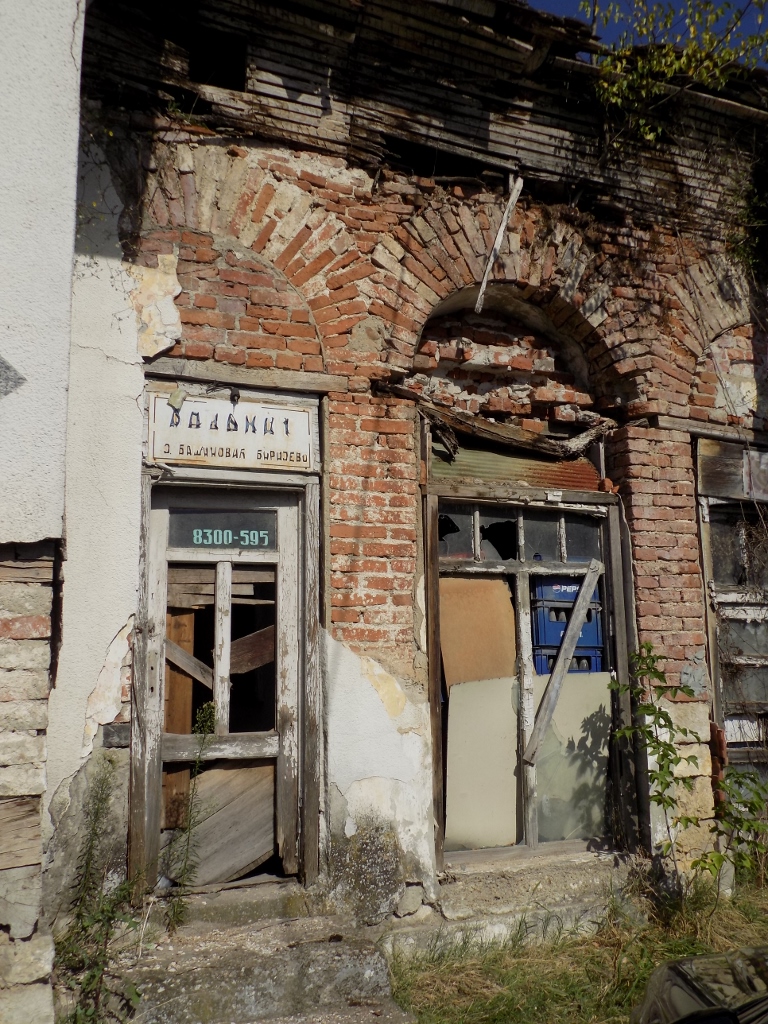 Stara mehana in Barajevo, details from the front facade
Stara mehana in Barajevo, details from the front facade
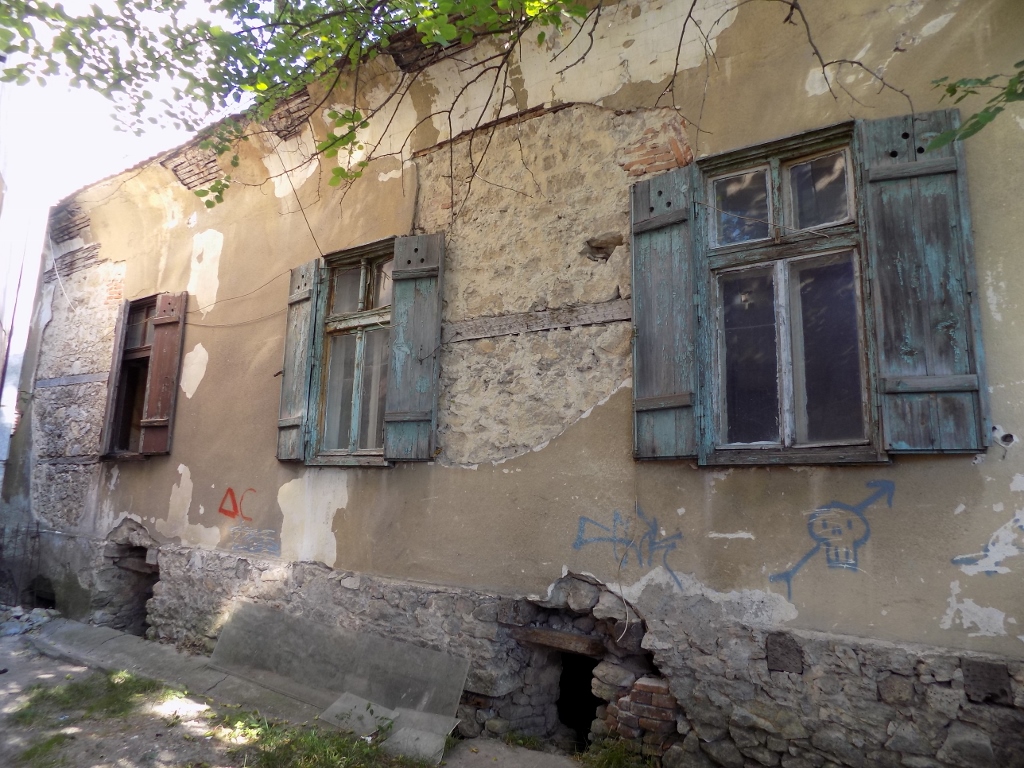 Stara mehana in Barajevo, details from the left side facade
Stara mehana in Barajevo, details from the left side facade
Although in the materials I had I came across different details linked to the construction and elements of this structure, it all paled in comparison to the “as-is state.” Admittedly, the documentation says that the changes in the interior have been made in line with the “requirements of the new owners and users.” When one goes to the back area, you can see that somebody lives there; there are new windows and I also noticed an air-conditioning unit. Still, none of that improved my general impression.
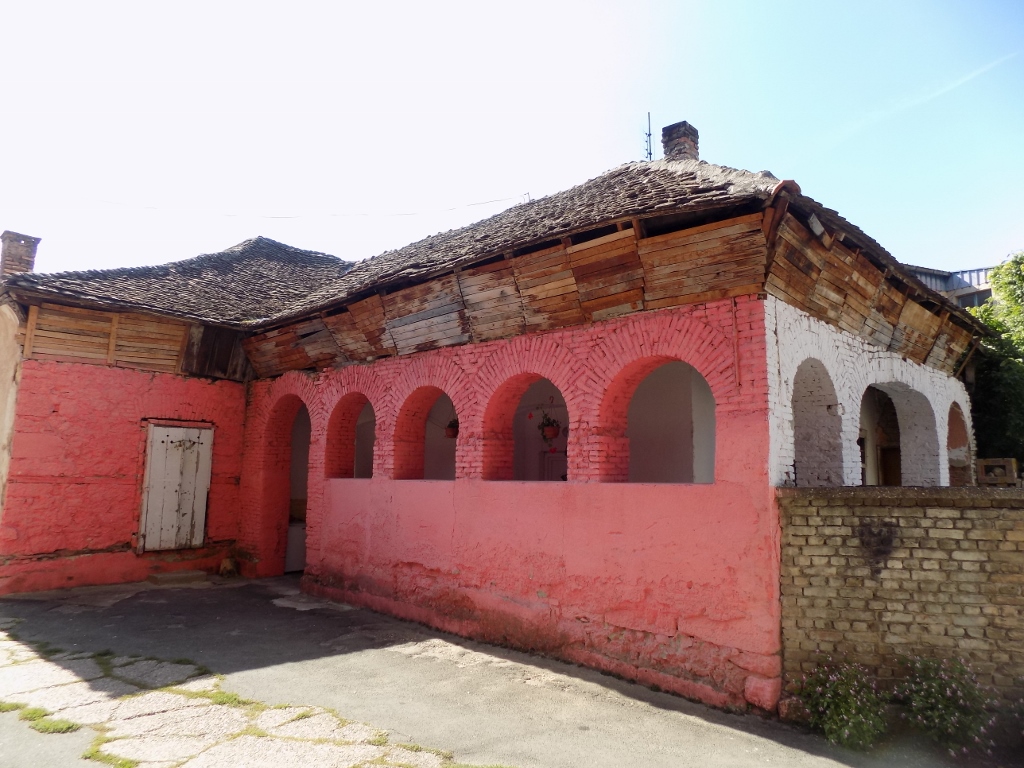 Stara mehana in Barajevo, the back area
Stara mehana in Barajevo, the back area
After this, my plan was to go to village Božidarevac, but as we were leaving downtown Barajevo I noticed a road sign saying that there were 4 km to a Church of St. Nicholas. We both agreed we should go there. First we stopped by (artificial) lake Duboki potok, which very much reminded me of another such lake in Resnik and at first in a completely confused state of mind I thought we might have gone all the way there. Of course, these are two different lakes, but same by the type of construction. So, we went for a very short walk there.
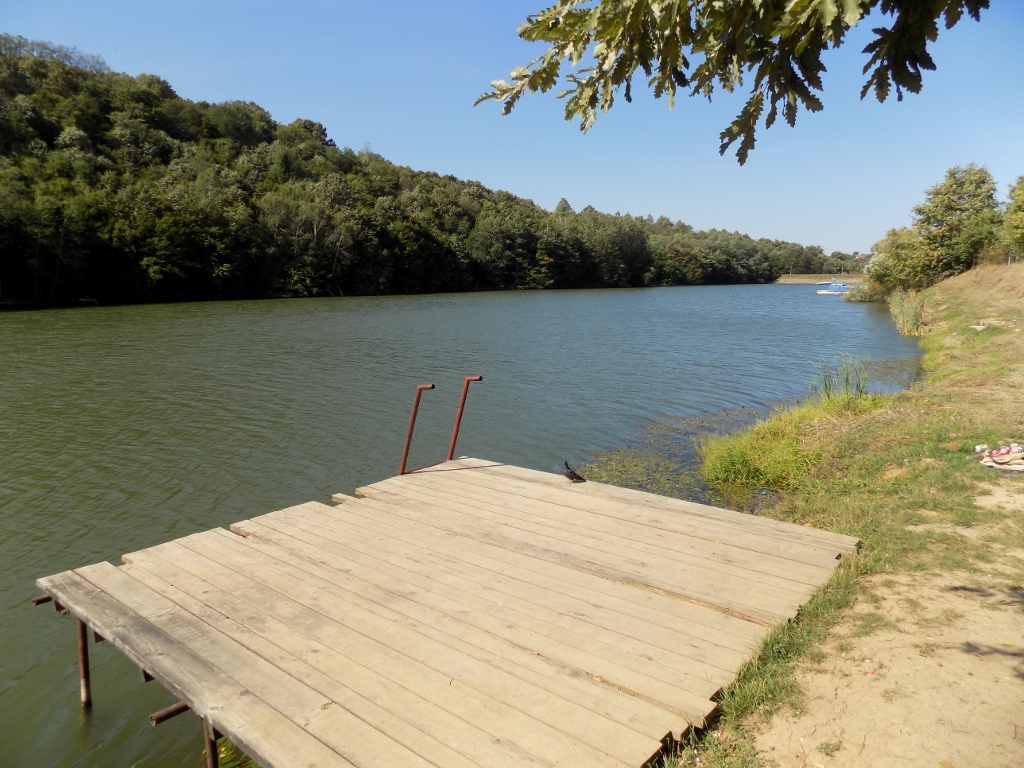 Duboki potok lake in Barajevo
Duboki potok lake in Barajevo
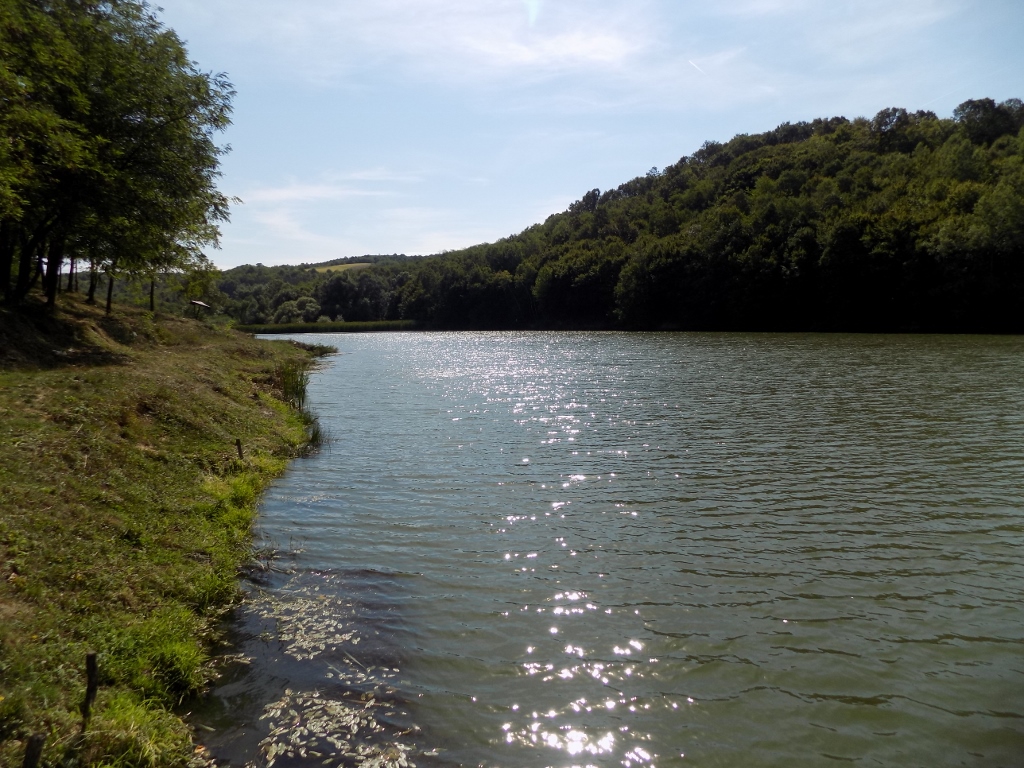 Duboki potok lake in Barajevo
Duboki potok lake in Barajevo
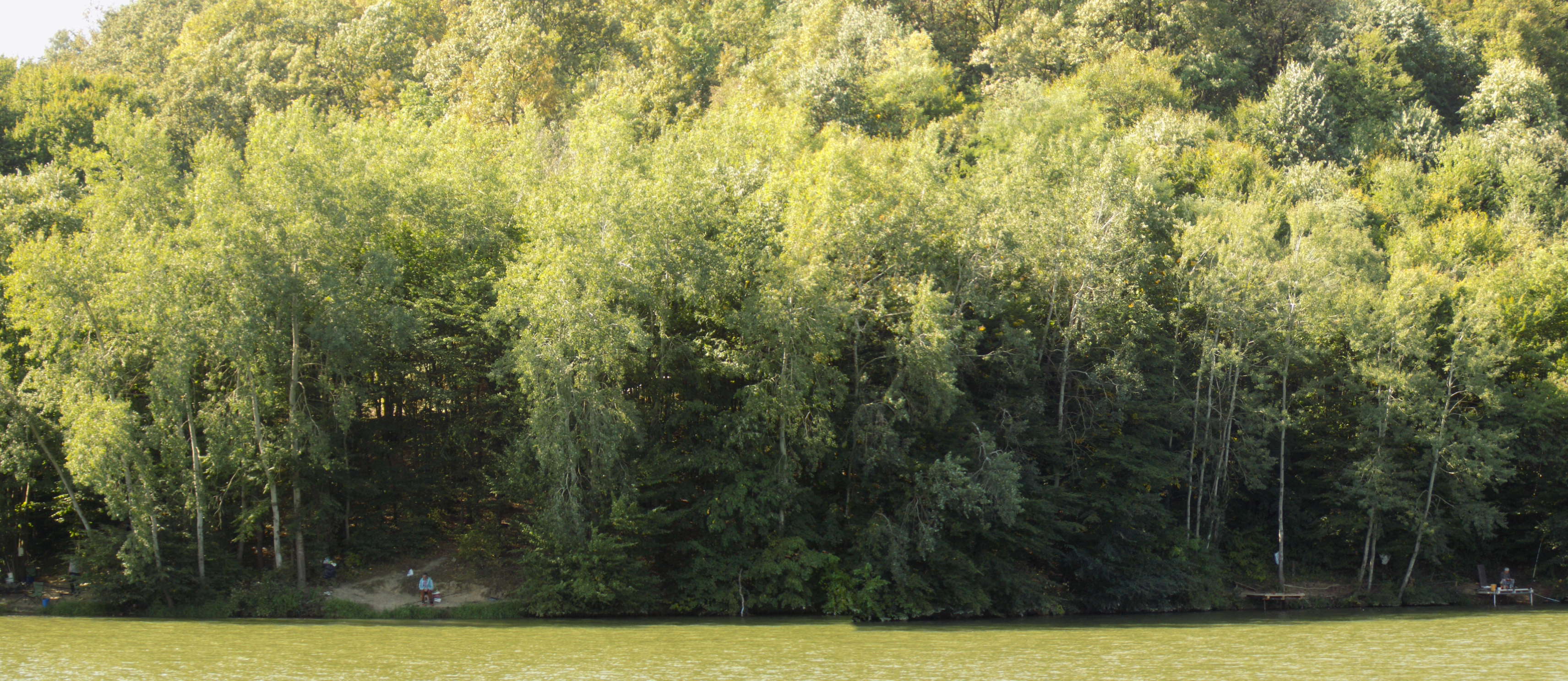
Then we drove to the Church of St. Nicholas and we thought it was more than 4 km to there, but it only seemed that way since we followed a winding narrow road. Still, no matter how almost tucked away this church may seem, the place where it is located is exceptionally nice and we were both very much pleased with the visit.
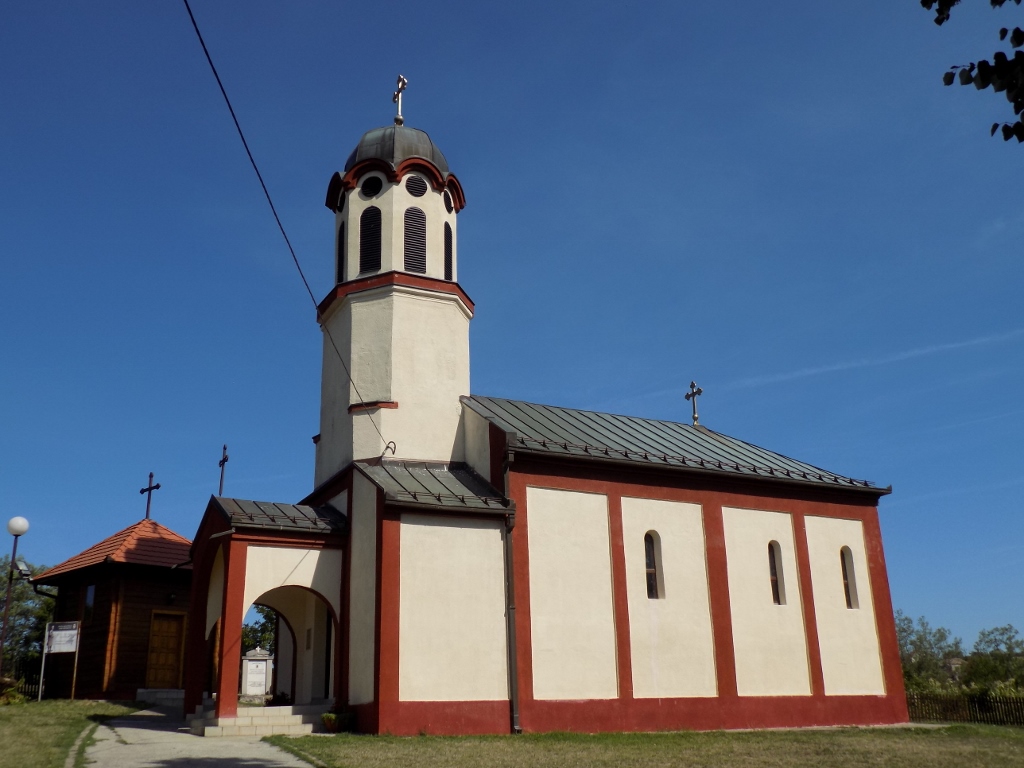 Church of St. Nicholas in Barajevo
Church of St. Nicholas in Barajevo
The church was built in 1903 and when one enters it is clear that the interior decoration is of a more recent date. It all looked incredibly impressive, perhaps because of the comparatively low ceiling. Although there were only Svetlana and me, there was a note in the narthex that women were not allowed in unless they had skirts of a decent length, while we both wore pants (men may enter only in trousers). So, I just took a photo from there and we both went out.
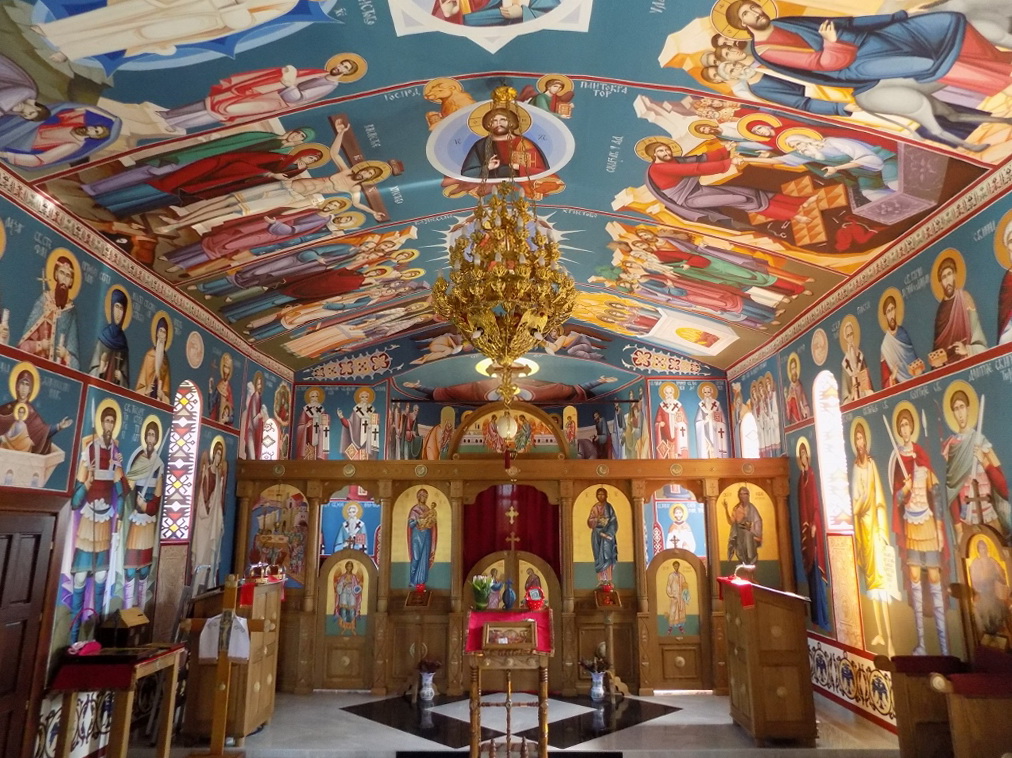 Church of St. Nicholas in Barajevo, the naos
Church of St. Nicholas in Barajevo, the naos
Here in the churchyard there are also numerous tombstones arranged on a long concrete slab and there is also a sign pointing out that this is WWI Memorial that includes monuments to the soldiers fallen during the Balkan wars and WWI (1912-1918).
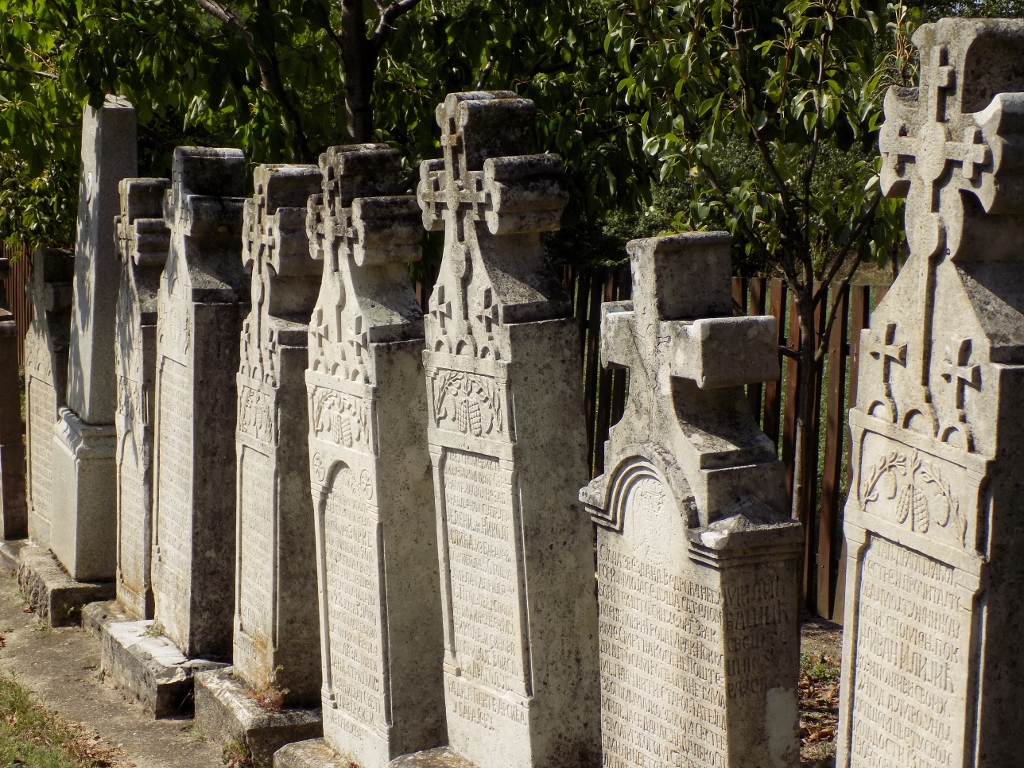 Tombstones to soldiers in the yard of the Church of St. Nicholas in Barajevo
Tombstones to soldiers in the yard of the Church of St. Nicholas in Barajevo
During history classes, we have all learned here that in the Balkan wars and WWI Serbia lost a huge number of inhabitants (according to the conservatively calculated, although official data from the 1919 Paris Peace Conference, only in WWI Serbia lost 28% of its population, i.e., more than a quarter!). And yet, it is only when one sees these numerous monuments with long lists of the names of those perished who came just from two small settlements near Belgrade that one starts to comprehend the real scale of this catastrophe. Today, many will ask, I believe, superfluously and cynically tinted question of the 21st century “pragmatists” if this was worth it. These people were ready to give their lives for what they believed were the values worth fighting for and we could perhaps only bow our heads while paying respect to the honourably fallen and abstain from being inappropriately too judgmental. It is, however, very nice that somebody is taking care of these monuments.
Having walked around the churchyard a little, we got back to the car, returned to Barajevo and then continued to village Božidarevac where there is yet another monument of culture – a school built in the 19th century (some data says this happened in the first half of the 19th century and some other that it happened in the second half). As it may be seen when one gets to the site, these details are irrelevant. Namely, there are only the foundations of the school left.
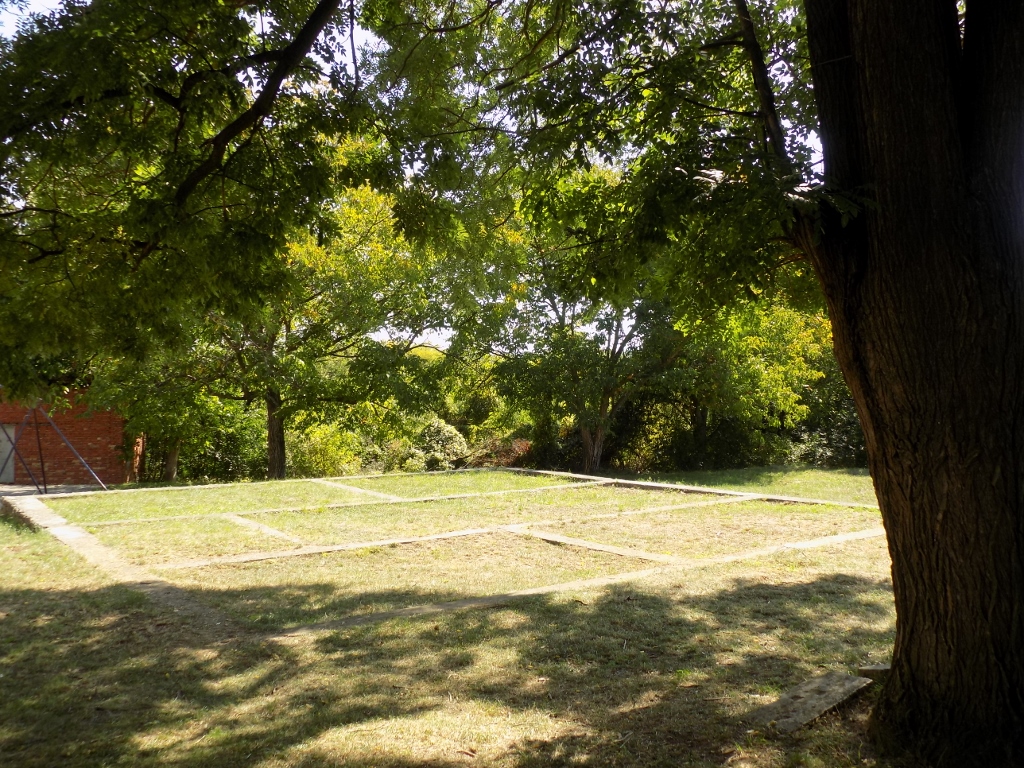 School in Božidarevac, monument of culture
School in Božidarevac, monument of culture
And yet, this place is essentially important, for already during the Serbian uprisings against the Ottomans at the beginning of the 19th century, the education system in Serbia started to develop since people had to be educated. By the way, I really LOVE the name of the line ministry in Serbia which uses word prosveta (coming from the Serbian word for enlightenment) being a synonym of education. Admittedly, I believe that we are still, and even more, far from that ideal, but if it’s any consolation, which it is not, the same could be said for the rest of the mankind. Be as it may, this school was originally built as a family residential building and then through the will of the owner it was given to the school. Well, THAT man was enlightened, although I have no idea what his education was like. Nowadays, this is rare to the point of non-existence.
These remains are located within the yard of the school which still functions as such today. As it says on a plaque displayed by the entrance, this new school building was constructed from 1908 to 1911 and was restored in 1991 when the centenary of education in Božidarevac was being marked. When Svetlana and I got here, I guess they had a recess and one teacher was outside with children. I asked her about details, but she called another lady who had been employed there for longer. We had a lovely chat with this wonderful and kind woman who actually drew our attention to that marble memorial plaque beside the sign with the name of the school. Then I took again a photo of the remains of the old school and a part of the contemporary school playground.
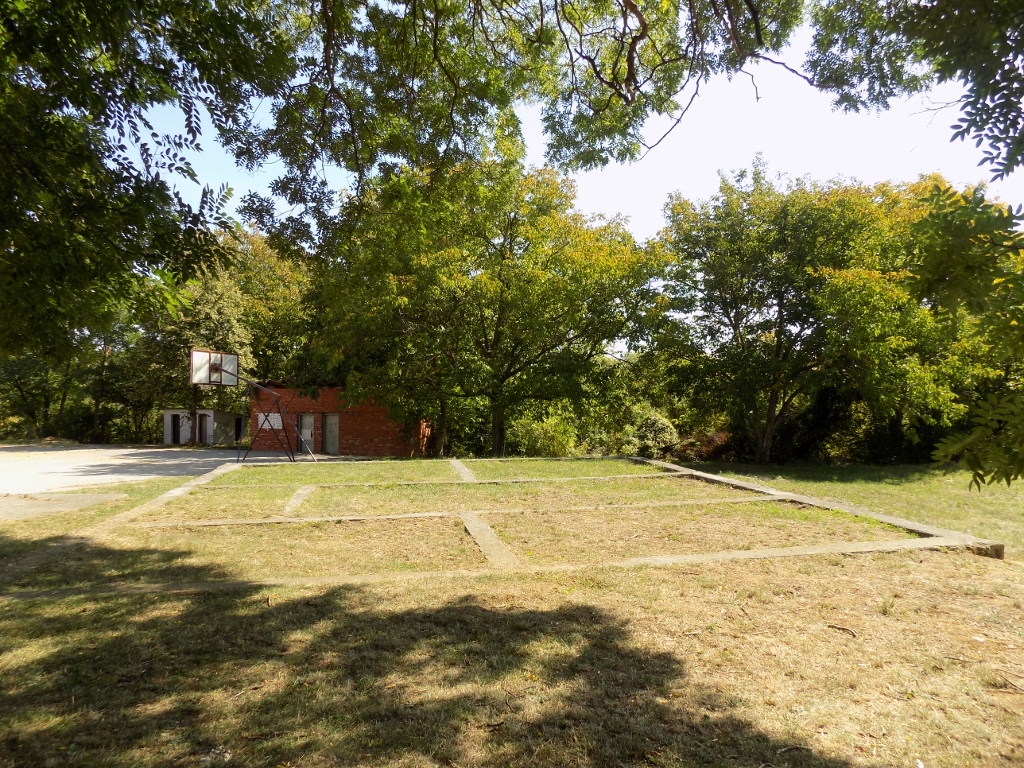 School in Božidarevac, monument of culture
School in Božidarevac, monument of culture
The next place according to our plan was village Beljina, but on our way there we made a couple of stops. The roads between these villages are full of curves and they keep going up and down, so I could not drive fast, which also meant that I could look around nicely. Thus I noticed a wonderful detail in the shape of some elements of the traditional architecture from one holding near the asphalt road we were following.
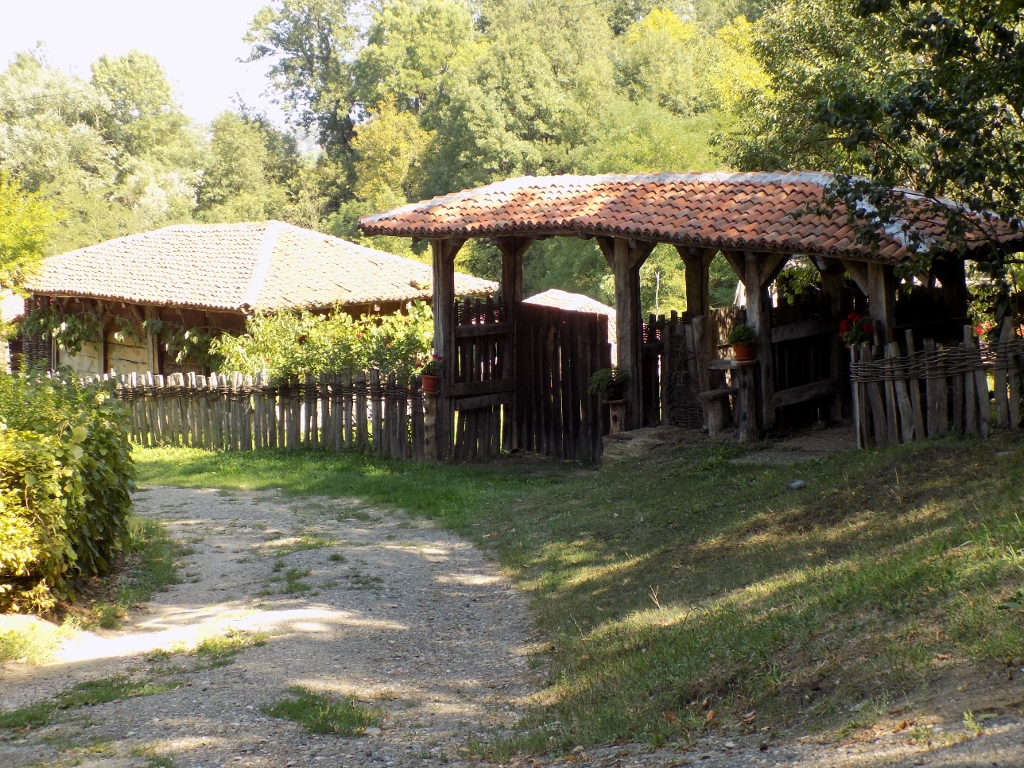 A holding near the road
A holding near the road
In one section, the road led along a ridge, so to speak, so I stopped in the middle of the road and got out since the landscape was stunning, while there were no other vehicles that I would bother.
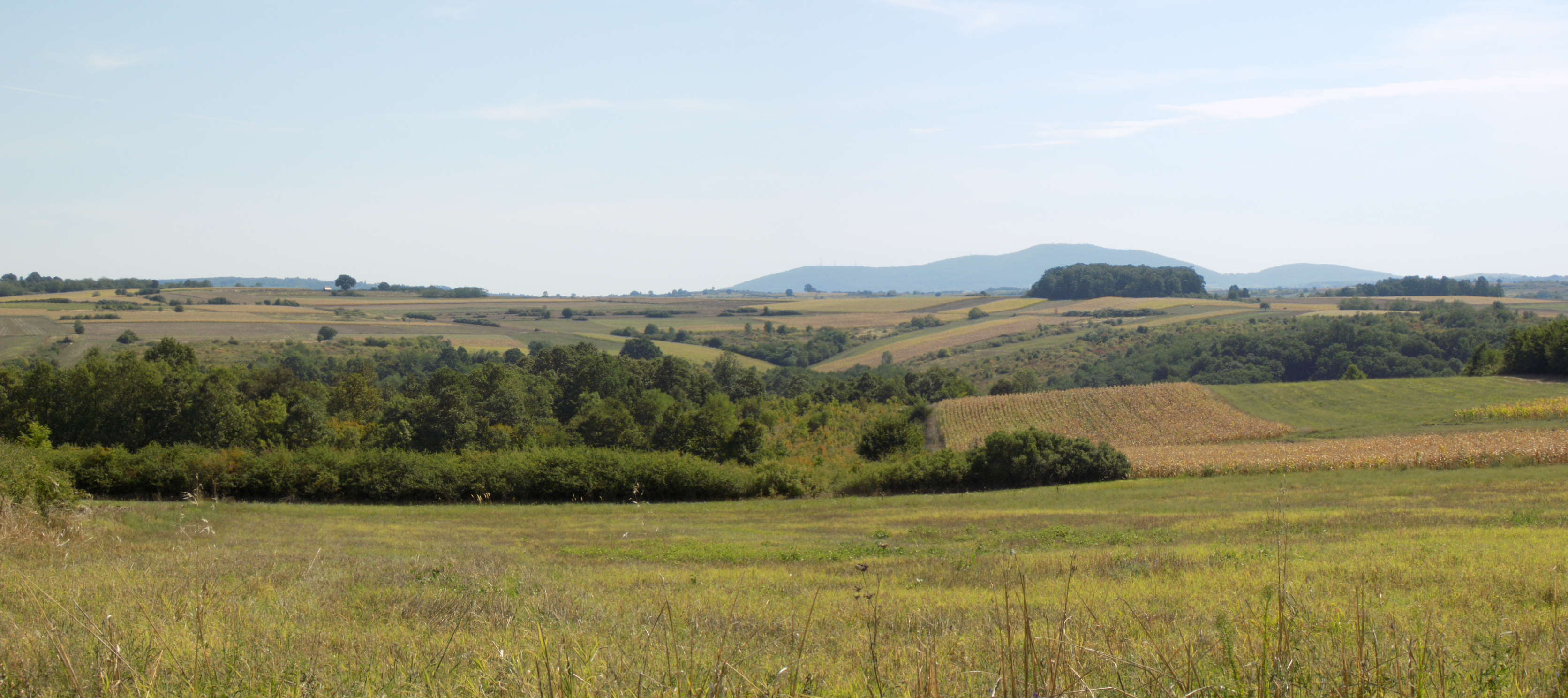
Then we came across a road sign that said Rimski most (Roman bridge) and that pointed to the left. There, on the left-hand side there was a clearing where we parked the car and got out. The only thing we could see on that spot was a built spring with fresh water pouring out.
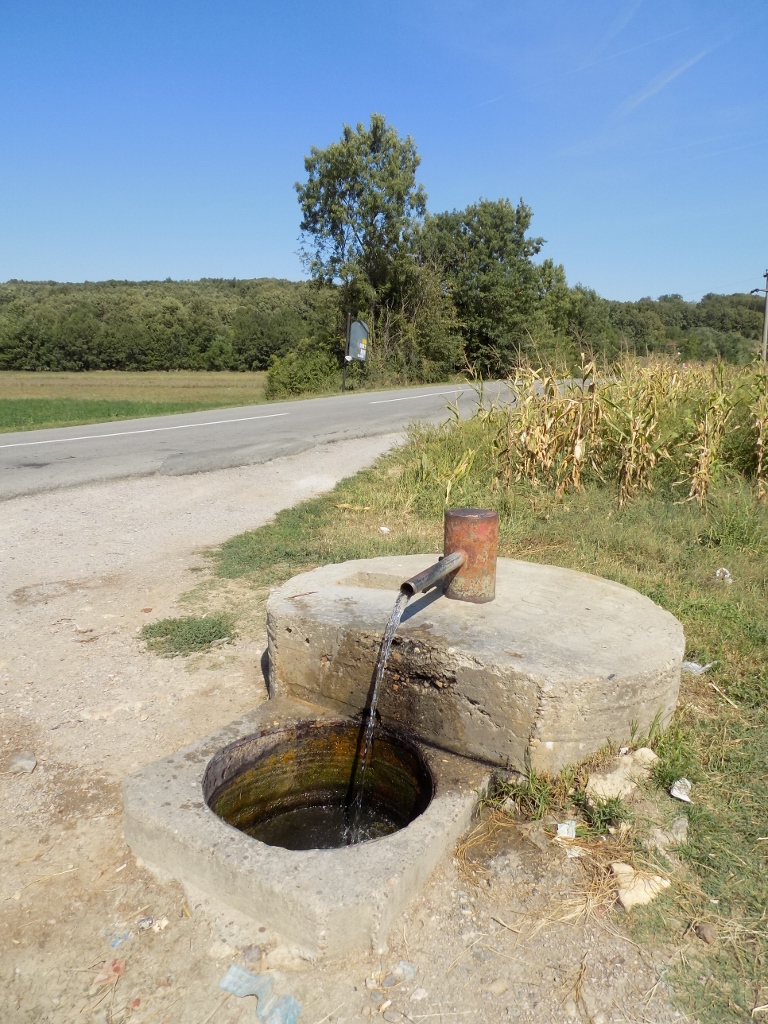 Water spring by the road
Water spring by the road
I did see a bridge some 20-30 metres farther down the road and I even went there, but this bridge had not seen a single Roman. Especially not an ancient Roman. I was utterly confused. I went back to the car and the water spring and all I could see there was a maize field and a wide overgrown path used for animal-drawn vehicles and tractors, I guess. Actually, I could only presume that this grassy path was used for these vehicles, since I could notice the rutting. So, I decided for the two of us to head over the narrow grassy patch that led between the maize field and this overgrown vehicle path, when all of a sudden ... I saw the Roman bridge!
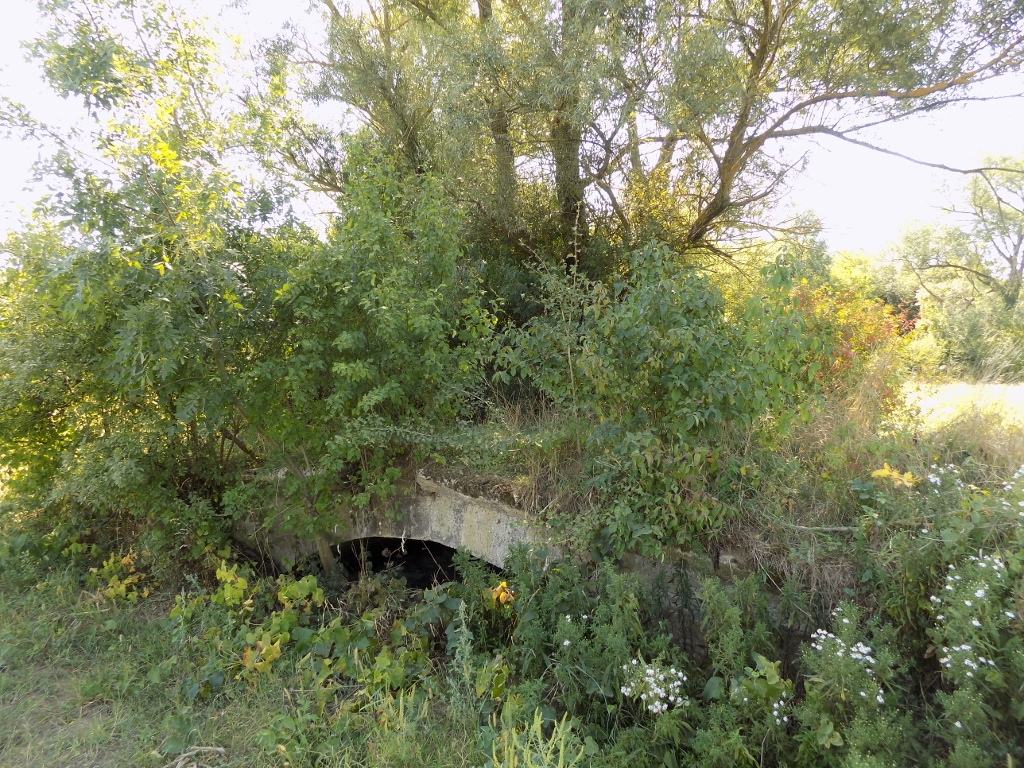 Roman bridge on the road to Beljina
Roman bridge on the road to Beljina
I was totally delighted that we noticed it, since apart from the road sign there was nothing else that would suggest the place where the bridge was located and it was easy to pass by without seeing it (while it is a mere dozen metres away from the asphalt road). We went to the other end and then even walked over the bridge. Svetlana headed first and although it occurred to me that it may not be safe, when I remembered the rutting of heavy vehicles, I realised the two of us were fine there.
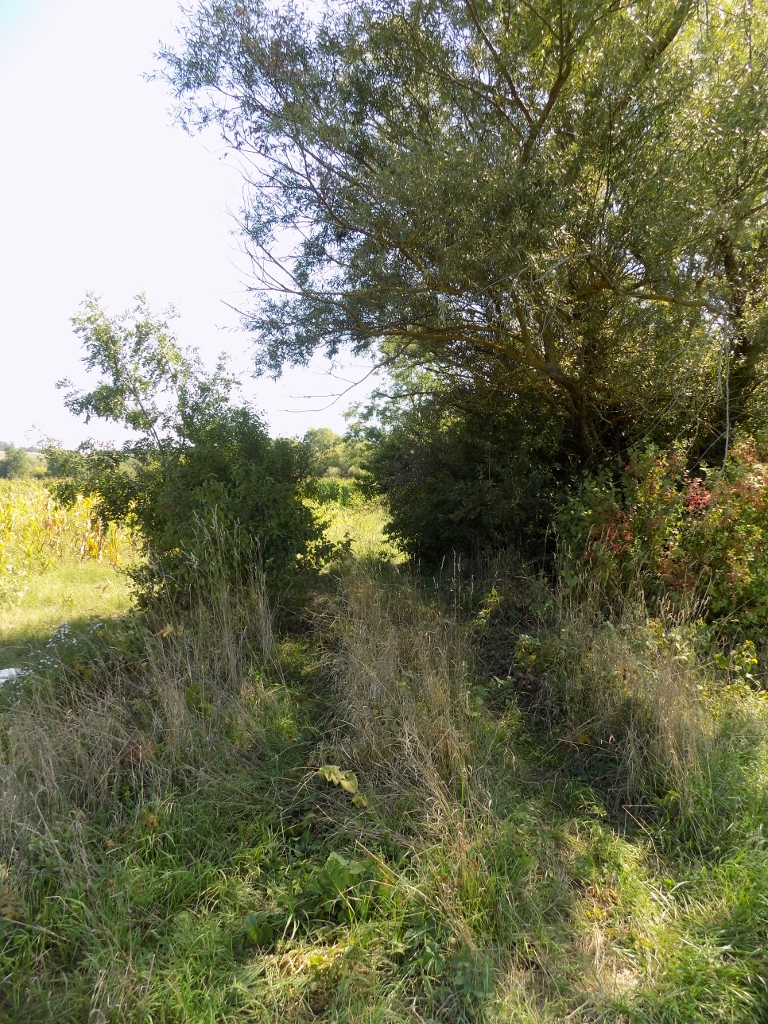 Roman bridge overgrown by grass
Roman bridge overgrown by grass
And then I laughed silently thinking about the “achievements” of the 21st century and all those who proudly like to point out that the mankind is progressing by the day. Weeeeeelllll.... These ancient Romans made a stone bridge some 2000 years ago which has survived the hot summers, the freezing winters, all kinds of armies and the vegetation and it can still sustain the weight of an animal-drawn vehicle or a tractor, while our “never better” devices can barely survive 3 to 4 years. Think about it!
After this, we drove to the centre of Beljina and parked there. First we entered a churchyard in which on a slope and surrounded by tall trees there is the Church of St. Archangel Michael.
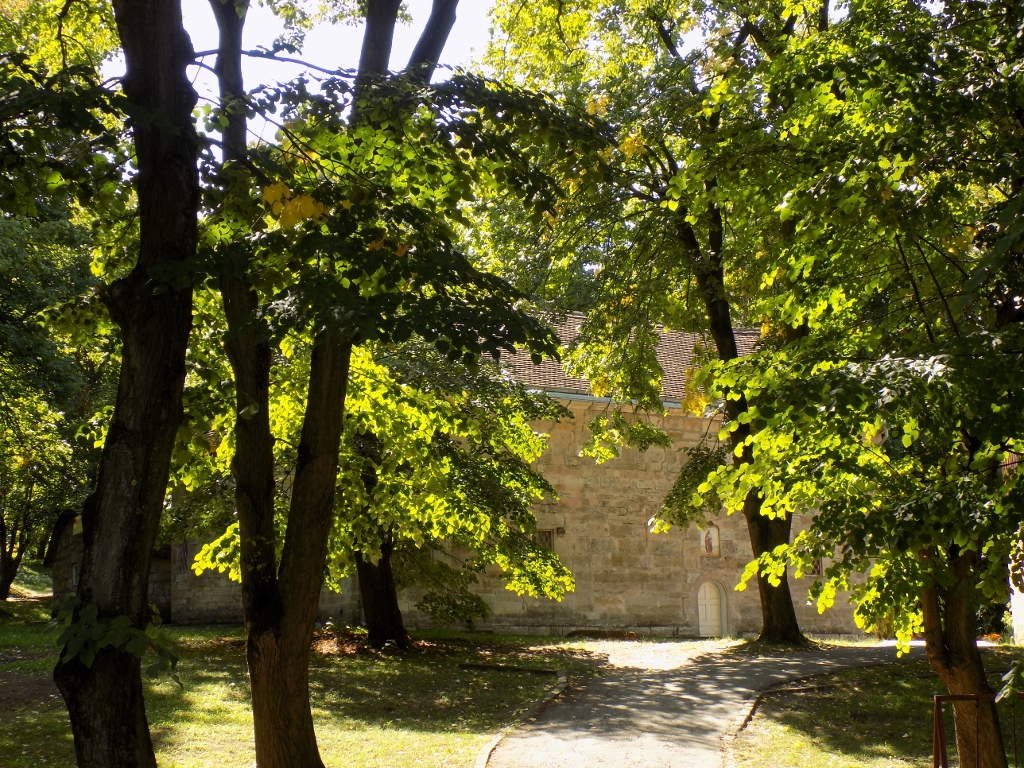 Church of St. Michael the Archangel in Beljina
Church of St. Michael the Archangel in Beljina
Because of the numerous trees and their foliage, one cannot see all of the church, but I got the best view at it from the southwest side.
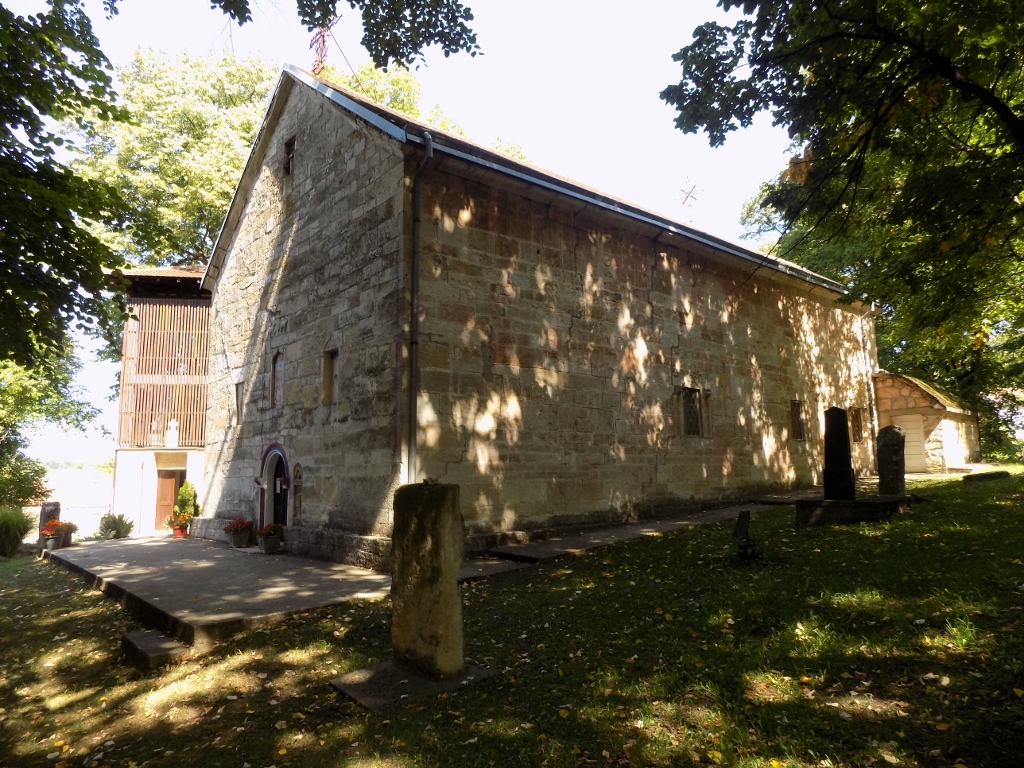 Church of St. Michael the Archangel in Beljina
Church of St. Michael the Archangel in Beljina
This is a monument of culture built in the period from 1813 to 1819 in the shape of a single-nave structure with a semi-circular apse in the east. In the photo above it is possible to see a small chapel added in the southeast part of the church, as well as numerous tombstones from the 18th and the 19th centuries. According to the data, there is also a late Antiquity stele here, which I believe is the one seen in the photo below. Namely, Beljina is one of the oldest settlements in the surroundings of Belgrade and archaeologists have found materials from the Neolithic period, as well as from the Antiquity and the Middle Ages.
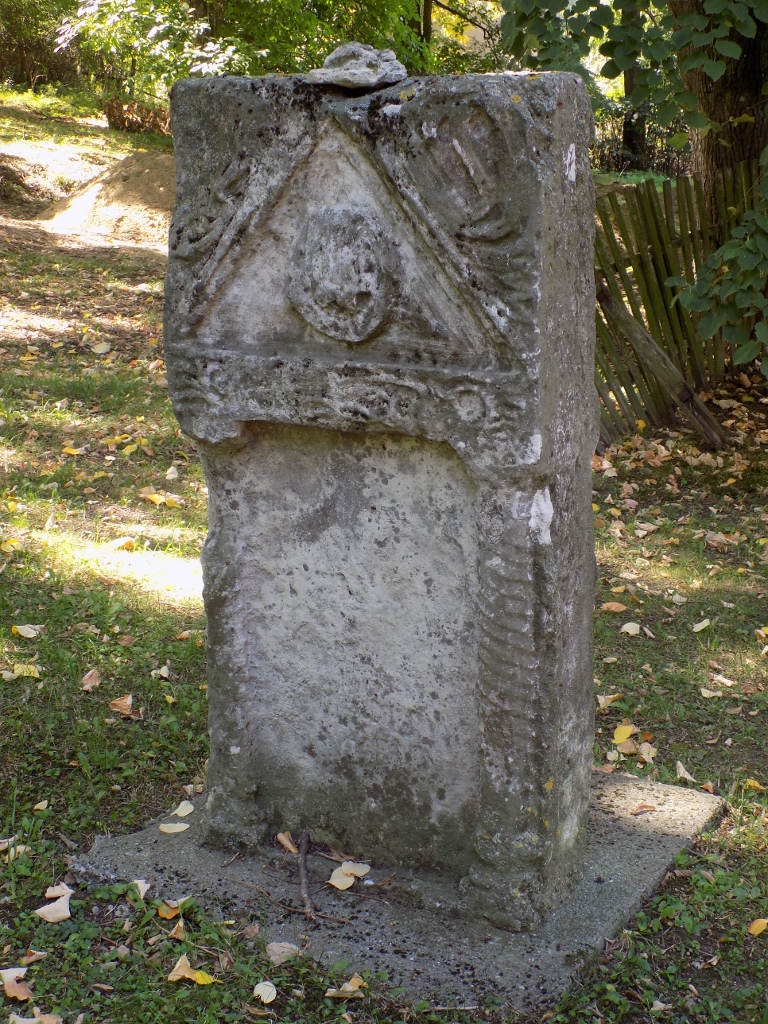 The presumed stele from the late Antiquity
The presumed stele from the late Antiquity
In the area near the northwest corner of the church, beside the access path, there is a gravestone from 1826 of a very interesting appearance.
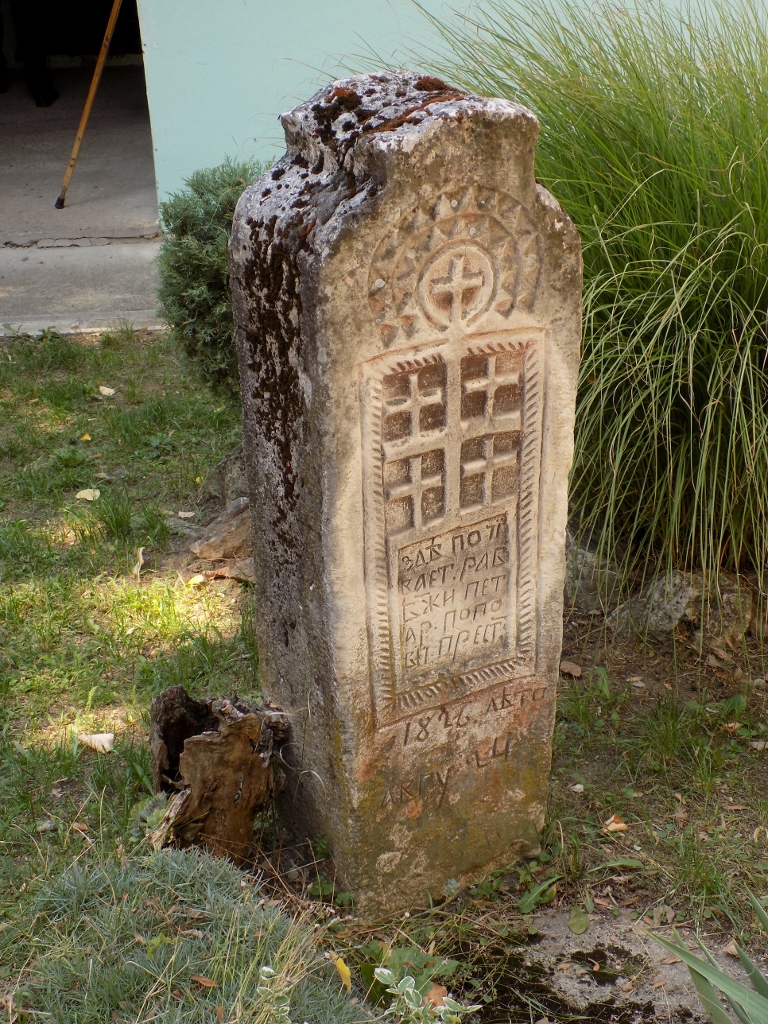 Gravestone by the Church of St. Michael the Archangel in Beljina
Gravestone by the Church of St. Michael the Archangel in Beljina
On the exterior of the church there is in places shallow relief decoration ...
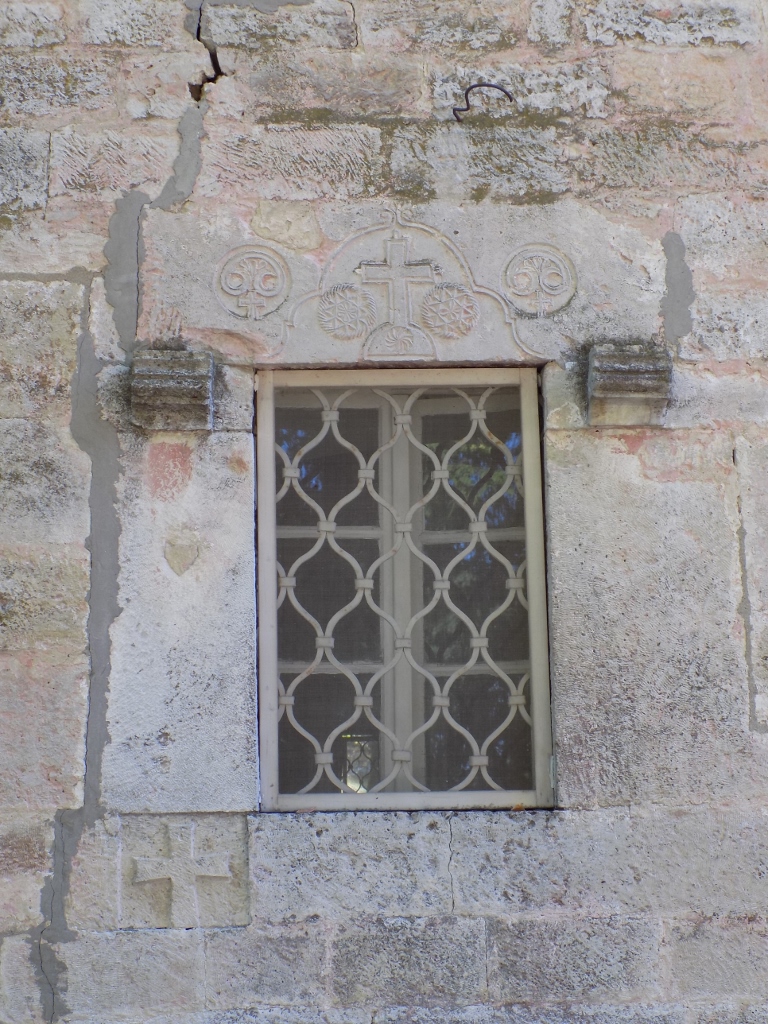 Window on the Church of St. Michael the Archangel as seen from the outside
Window on the Church of St. Michael the Archangel as seen from the outside
... while the interior is marked by a barrel vault.
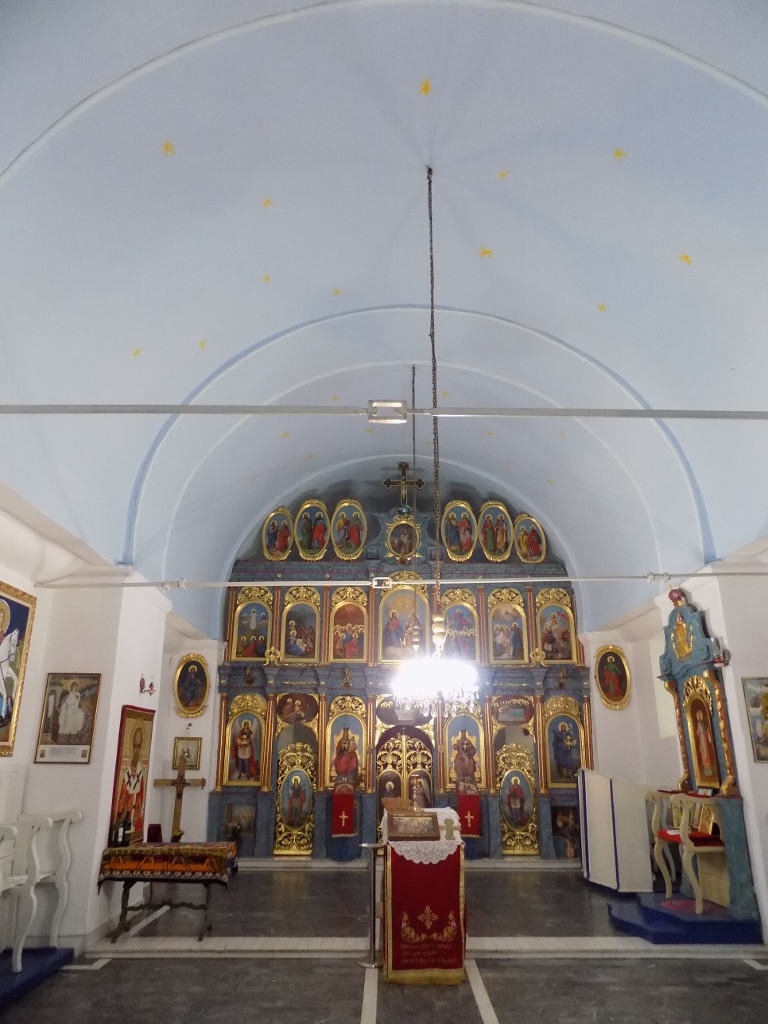 Interior of the Church of St. Michael the Archangel in Beljina
Interior of the Church of St. Michael the Archangel in Beljina
While looking around the interior of the church, I noticed on the left wall, closer to the entrance, a plaque which exhibited an inscription that was not logically written, but spoke volumes. For those who are not familiar with the Cyrillic script and Serbian, here is the text: “In this temple ordained a priest in 1899, Sava Magazinović, 1870-1932, and his granddaughter Dolores, 1941-1943. This memory is displayed by daughter and mother, Dr. Saša Božović.”
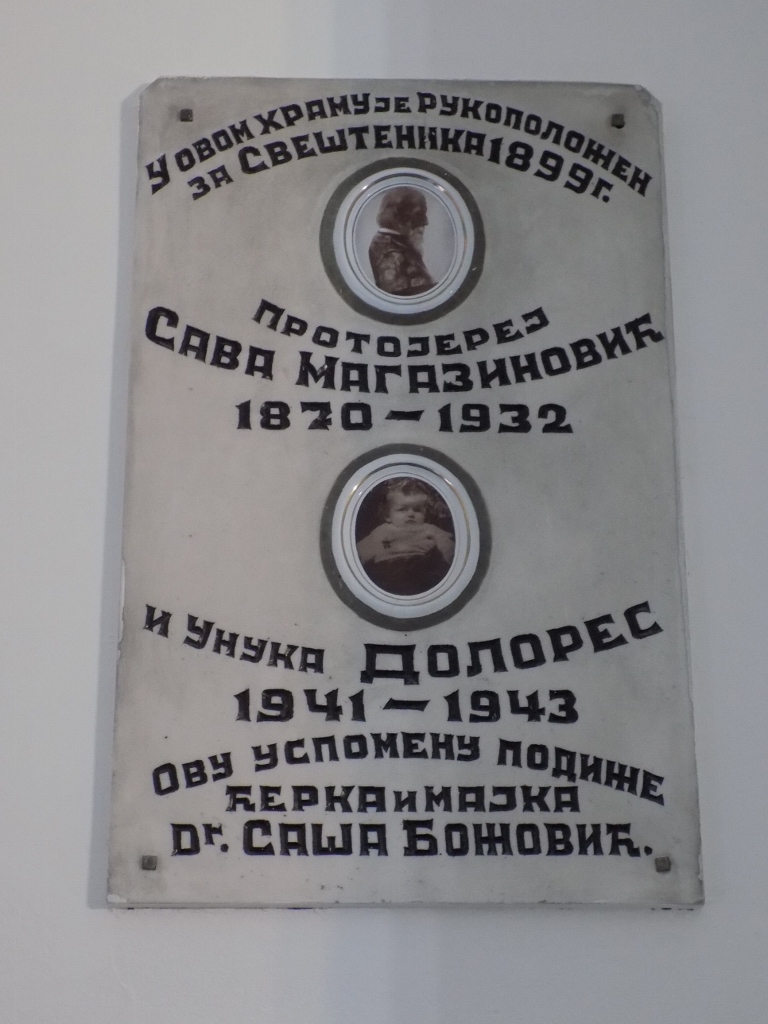 Plaque at the Church of St. Michael the Archangel in Beljina
Plaque at the Church of St. Michael the Archangel in Beljina
These names will mean nothing to younger Serbian generations or people from abroad, but it needs to be said that Dr. Saša Božović is the author of book “To You, My Dolores” that was cried over by the whole country and was declared the most read book in the SFRY in 1980. Her small daughter to whom this book is dedicated died of freezing, exhaustion and starvation during the Battle of the Neretva (WWII) and this plaque certainly represents a gravestone of a kind.
According to the data I had, there is a 19th century spatial-cultural-historic ensemble in Beljina entitled Čaršija in Beljina. Word čaršija (çarşı) comes from Turkish and denotes a centre of economic and commercial activities in a settlement, an open market. Here, during the first half of the 19th century, a čaršija got formed along the main road, but, as I’ve already mentioned, material remains of cultural and historic value from significantly older periods have been found in Beljina. What belongs to the Čaršija and can easily be seen today is the Ljubinković [family] house and mehana from the middle of the 19th century, that is nowadays a part of a company the yard of a which is behind the house located by the very road, thus continuing with the čaršija’s function. By the way, mehana is also of a Turkish origin (meyhane) and is used for a traditional restaurant or a bar.
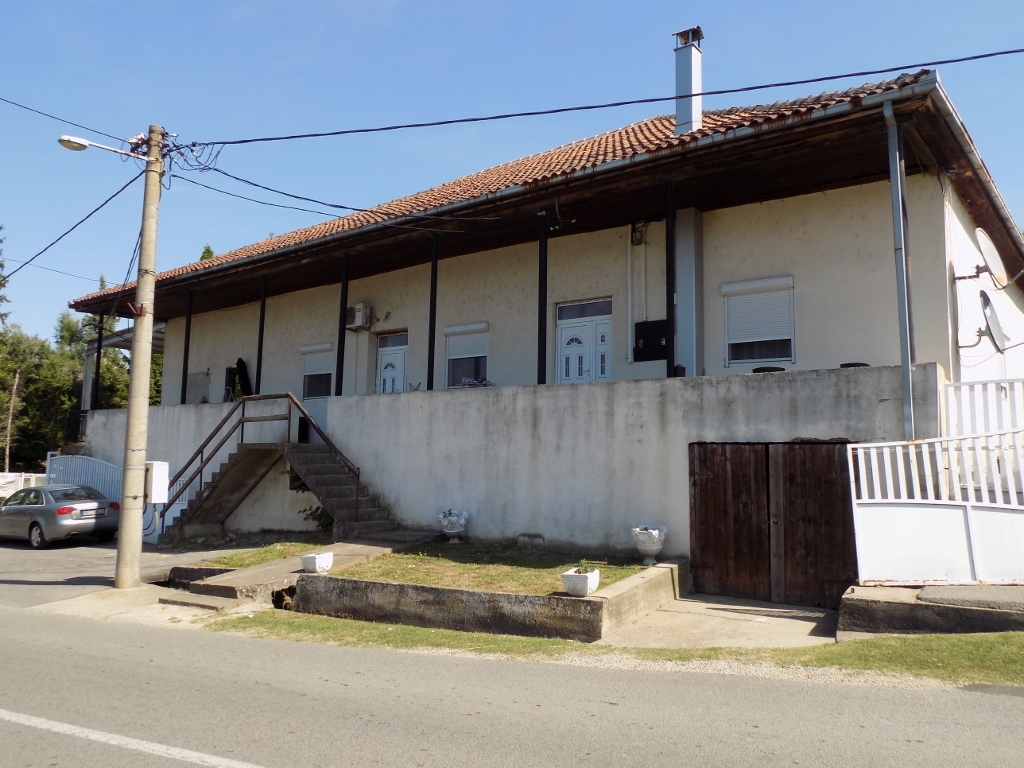 Ljubinković [family] house and mehana in Beljina
Ljubinković [family] house and mehana in Beljina
Having taken photos of the former mehana, we got into the car again and headed for Leskovac. But, although my cousin is from Leskovac and that is also where my parents come from, we were not going to the town in the south of Serbia, but to a village of the same name that is situated in this area. Since a lot of people mix up these two settlements, village Leskovac is often called Kolubarski Leskovac (after the nearby river Kolubara). So, there we first went to the Church of the Holy Great Martyr Demetrius which is a monument of culture and which was built in 1892.
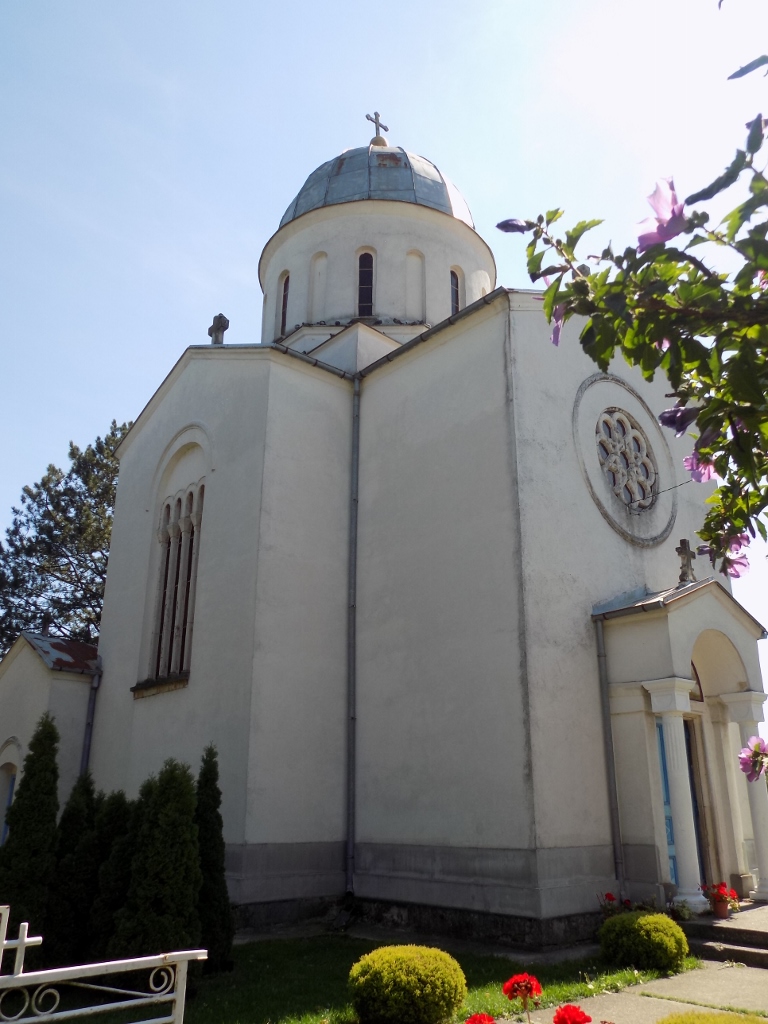 Church of the Holy Great Martyr Demetrius in (Kolubarski) Leskovac
Church of the Holy Great Martyr Demetrius in (Kolubarski) Leskovac
The church was built in the place of the original wooden church from the 17th century and it was shaped in the spirit of the Serbian-Byzantine style that was predominant in the Serbian church architecture at the end of the 19th century. The church has a free cross plan and next to it there are also a bell tower and a parish house, as well as a place for lighting candles, and all of this is situated within a nicely maintained churchyard.
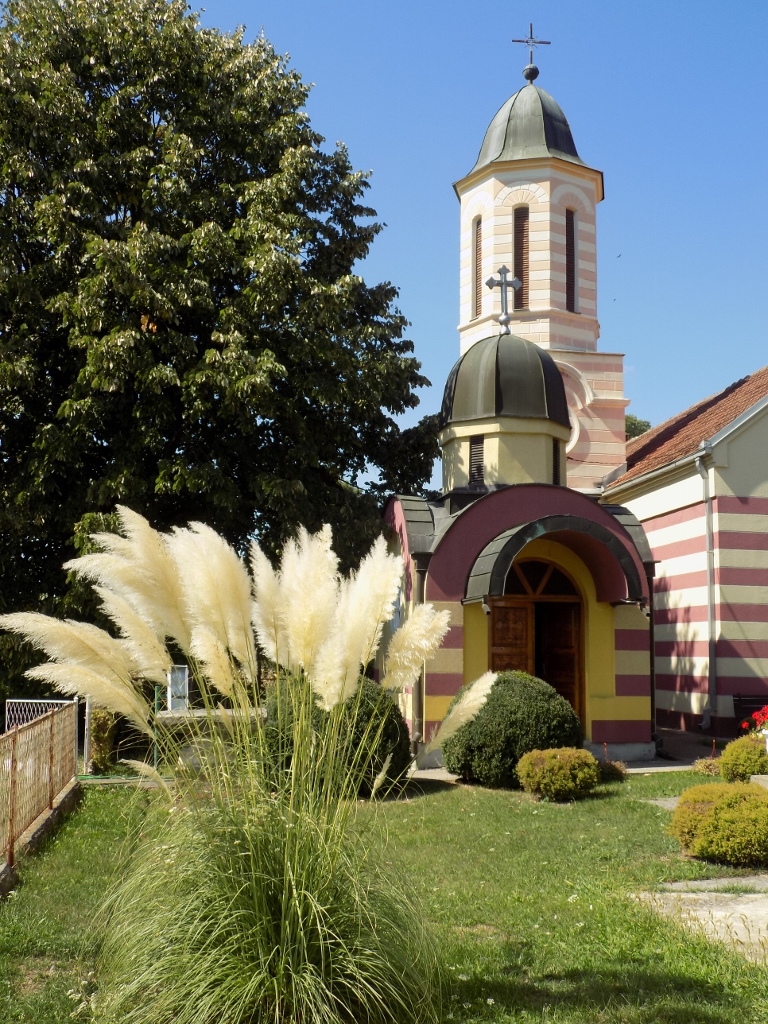 Part of the yard around the Church of the Holy Great Martyr Demetrius in (Kolubarski) Leskovac
Part of the yard around the Church of the Holy Great Martyr Demetrius in (Kolubarski) Leskovac
The interior of the church is rather modest, but very pretty and it is dominated by the iconostasis.
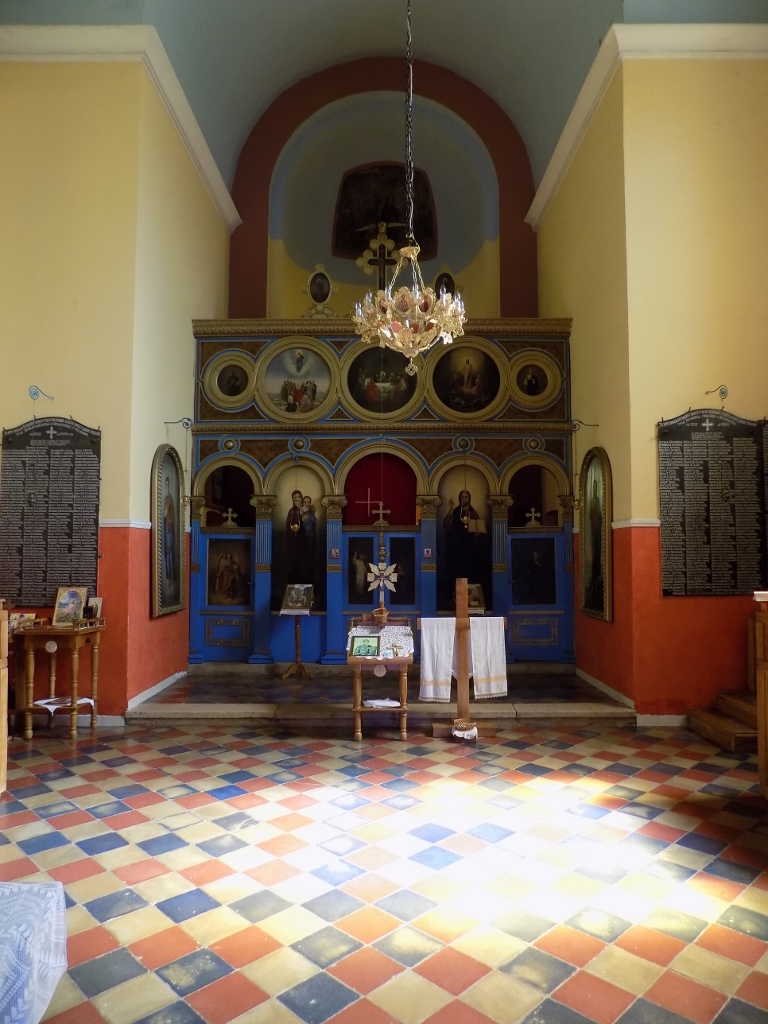 Interior of the Church of the Holy Great Martyr Demetrius in (Kolubarski) Leskovac
Interior of the Church of the Holy Great Martyr Demetrius in (Kolubarski) Leskovac
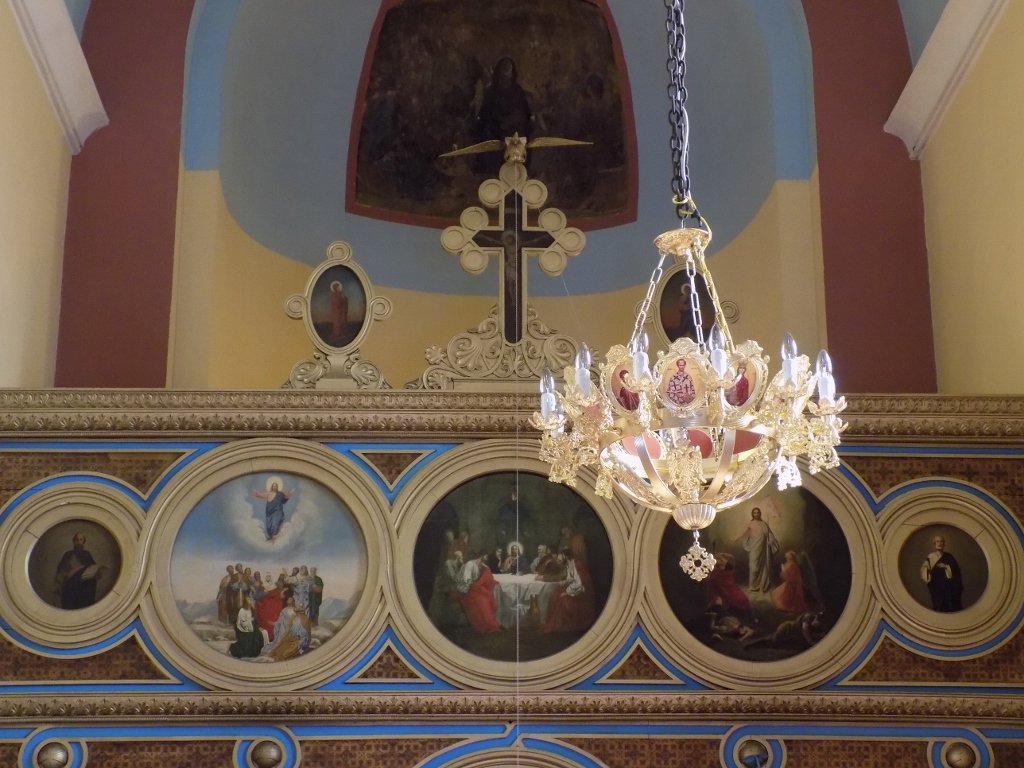 Interior of the Church of the Holy Great Martyr Demetrius, a detail
Interior of the Church of the Holy Great Martyr Demetrius, a detail
Here, too, on the marble slabs to the left and right from the iconostasis we could see the evidence which the wars from the period of 1912-1918 left in this village and its surroundings in the form of long lists with the name of the fallen. In addition, in the churchyard, there is also an ossuary of the Serbian soldiers from the period of 1914-1918.
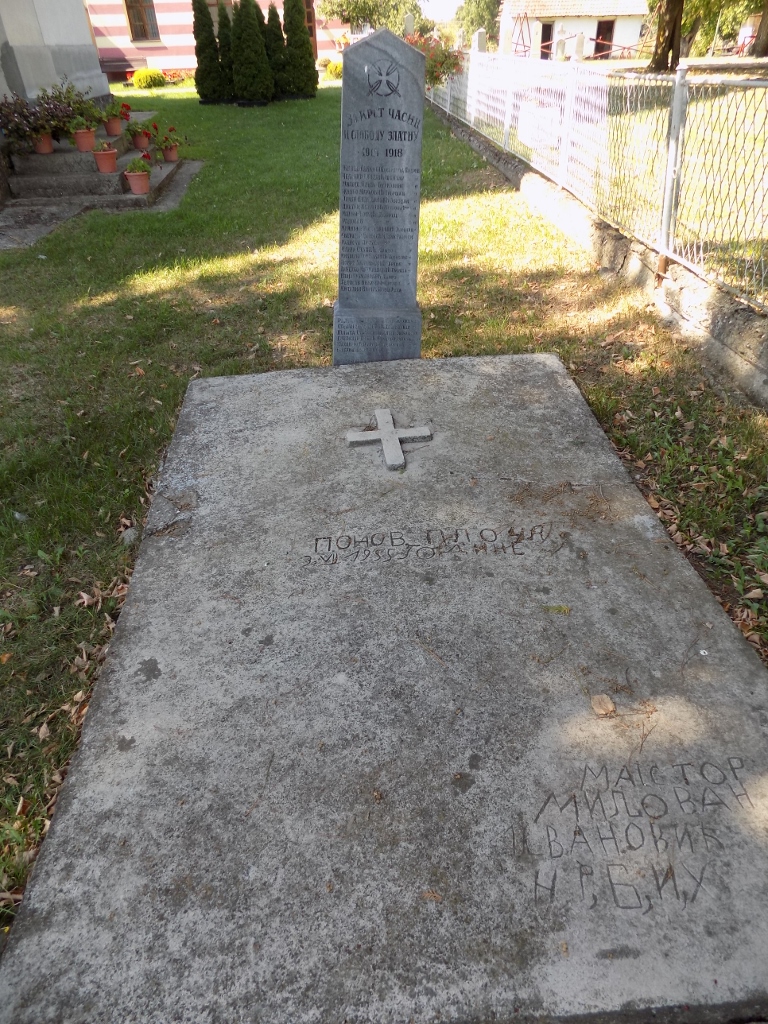 Ossuary in the yard of the Church of the Holy Great Martyr Demetrius in (Kolubarski) Leskovac
Ossuary in the yard of the Church of the Holy Great Martyr Demetrius in (Kolubarski) Leskovac
When we finished with this sightseeing, we got back to the car, but we did not enter right away since I had a dilemma. In village Leskovac there is another monument of culture (an old house) which, according to what I had read, was almost completely ruined, but I still felt sorry not to see it in person. The problem was that I had no idea where it was. While I was wondering what to do, a young man came by in his car, so I stopped him and asked if he knew where that house I was looking for was. As it turned out, he did not know. I wished him a pleasant day still hesitating, when all of a sudden a man came from the house opposite the church. I guess he must have been in his yard and heard something was going on, so he came out to help. I told him what I was looking for and he gave me the directions, for he knew exactly what I was talking about. We chatted a little more, since I had noticed earlier in his garden and had taken a photo of an interesting “sculpture.”
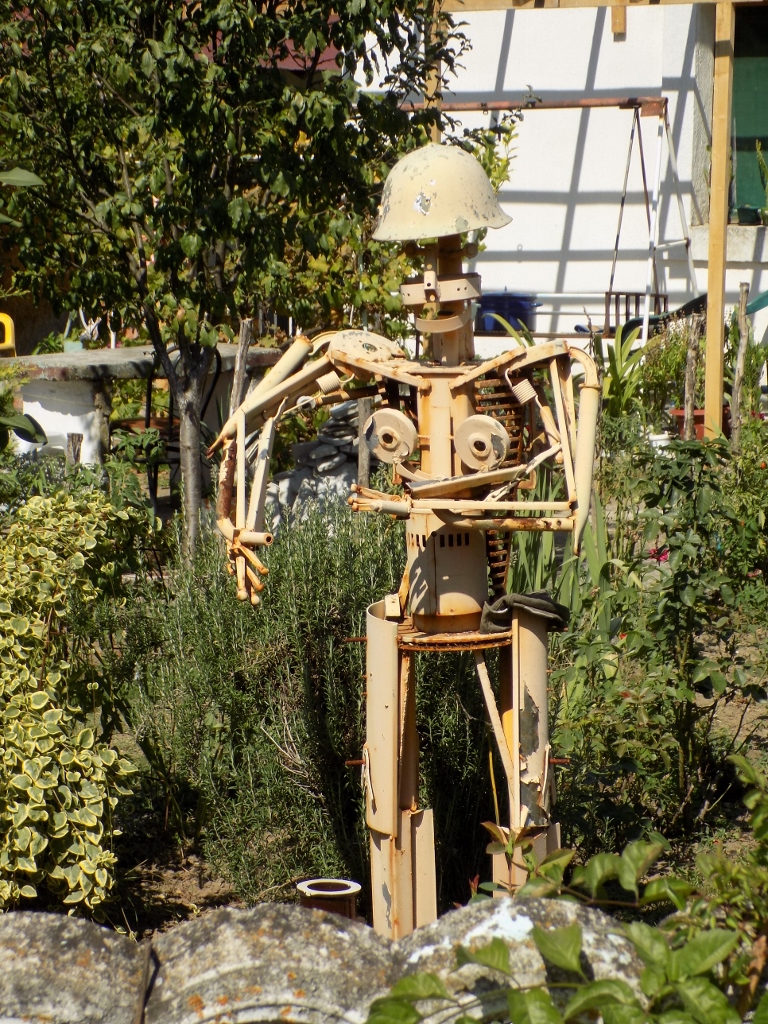 Garden sculpture in (Kolubarski) Leskovac
Garden sculpture in (Kolubarski) Leskovac
Namely, some time before, his step-son had some scrap metal and wanted to sell it, but the buyers offered some ridiculous sum and he refused to go through with it, opting rather to use the scrap metal for the purpose of art. Now the result of this effort stands in their garden and can easily be seen from the street. The man told us that sometimes children enter the garden in order to take photos with the sculpture.
So, our next destination was the old house of the Dimitrijević family, but since it is quite tucked away, this kind man told us we should get to a local pub and then there they would tell us how to proceed. We got to the pub where we wanted to sit, have a rest and take coffee, but – the pub was closed (on account of the siesta). Again, a problem. Then I saw a young man walking along the street and talking on the phone. I waved at him as we were to pass each other and I asked him about the house, but he did not know where it was. Hmm, what to do now? Nothing, I just waited for a few seconds and then a new local neighbour came out. I explained what we were looking for, he said he did not know, for he had come to live there only in the last couple of years in a house he had bought a little earlier. He even jokingly called himself a “covid tourist” – for, since the pandemic had started, he and his wife had been living there in their house in the village stress-free. But, he said, Laza would know. Who’s Laza? Well, that was another neighbour, from a house right across the street. We went to Laza’s and I wondered aloud if Laza was at home. This man said he certainly was for the two of them had worked on something a couple of minutes before. We got to the back entrance, but there was not a trace of Laza. The man called him, but Laza did not answer back. As it turned out, he was slightly hard of hearing, so the neighbour found him in the house and as it turned out Laza knew perfectly well which house I was talking about. He said immediately that we could go there together and he would take us. He was about to get into his car, but I said we had a car ourselves, so Laza, Svetlana and I got into my car and drove a couple of hundred metres farther.
The old house of the Dimitrijević family, which is a monument of culture, was made of natural materials in the half-timber style in the first half of the 19th century. The data about it says that it is characterised by a unique organisation of the space within the house and that in this regard back in the day it constituted an exceptional example of an improved style of the life in a residential structure. It is located within a yard belonging to a family that lives in a very pretty and new house, but neither Svetlana nor I (nor Laza) wanted to enter the yard. It sufficed to see the house from the outside of the fence.
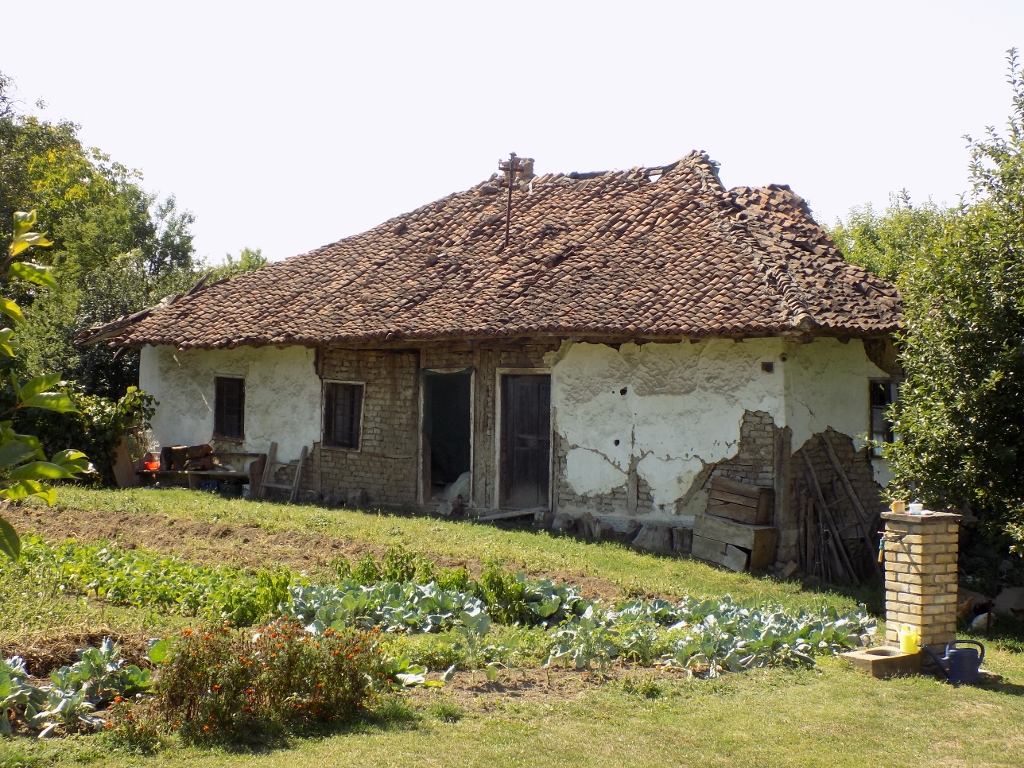 Old house of the Dimitrijević family in (Kolubarski) Leskovac
Old house of the Dimitrijević family in (Kolubarski) Leskovac
I had already read that the house had meanwhile turned into a mere facade, but I wanted to see this more clearly, so I walked around the fenced-off plot of land and indeed I saw this.
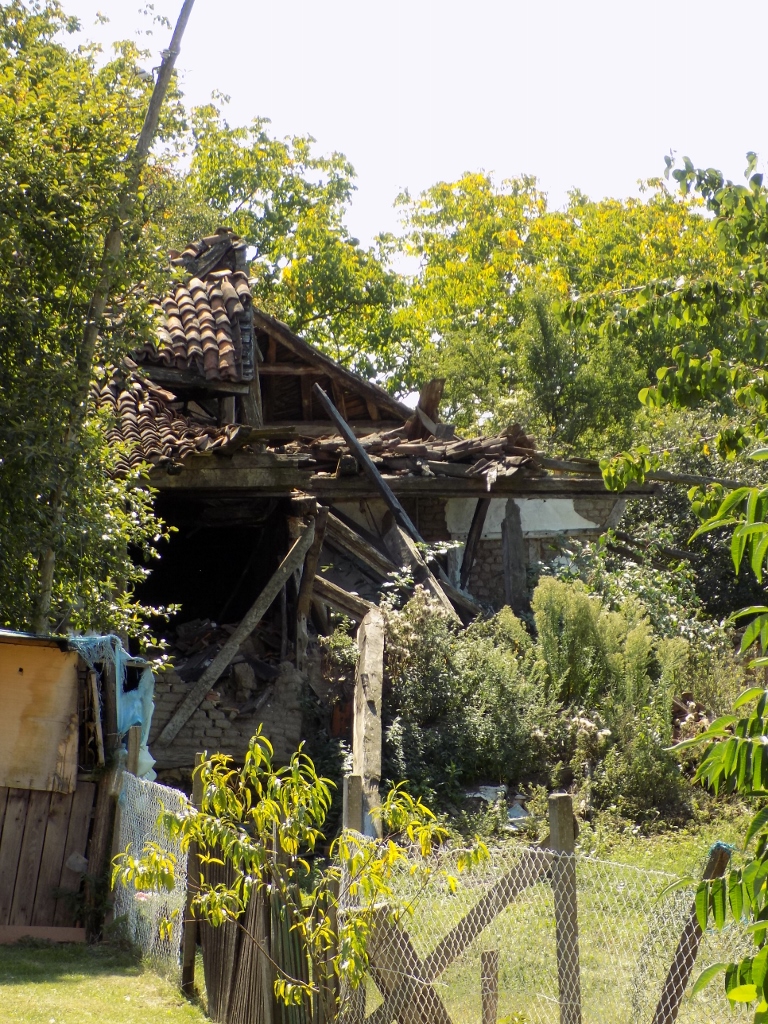 Old house of the Dimitrijević family in (Kolubarski) Leskovac, side view
Old house of the Dimitrijević family in (Kolubarski) Leskovac, side view
I also saw the owner of the new house there, so we had a nice chat and we both expressed regret that the old house was in such a sad state. It is clear to me that the current owners certainly don’t have the money or the interest, let alone the technical knowledge, in order to have the house restored. And yet, it’s a pity, for in this way it just deteriorates further.
I thanked the kind owner of the house, we took Laza back to his house, thanked him and the kind neighbour, and then my cousin and I returned to the centre of Leskovac and the church from where we continued to the next village and that was Veliki Borak. Although I kept feeling sorry that the old house of the Dimitrijević family, which is a monument of culture, was in such a sad state, along the way I noticed some other, less old houses, which I found very pretty, so I stopped near one and took a photo of it.
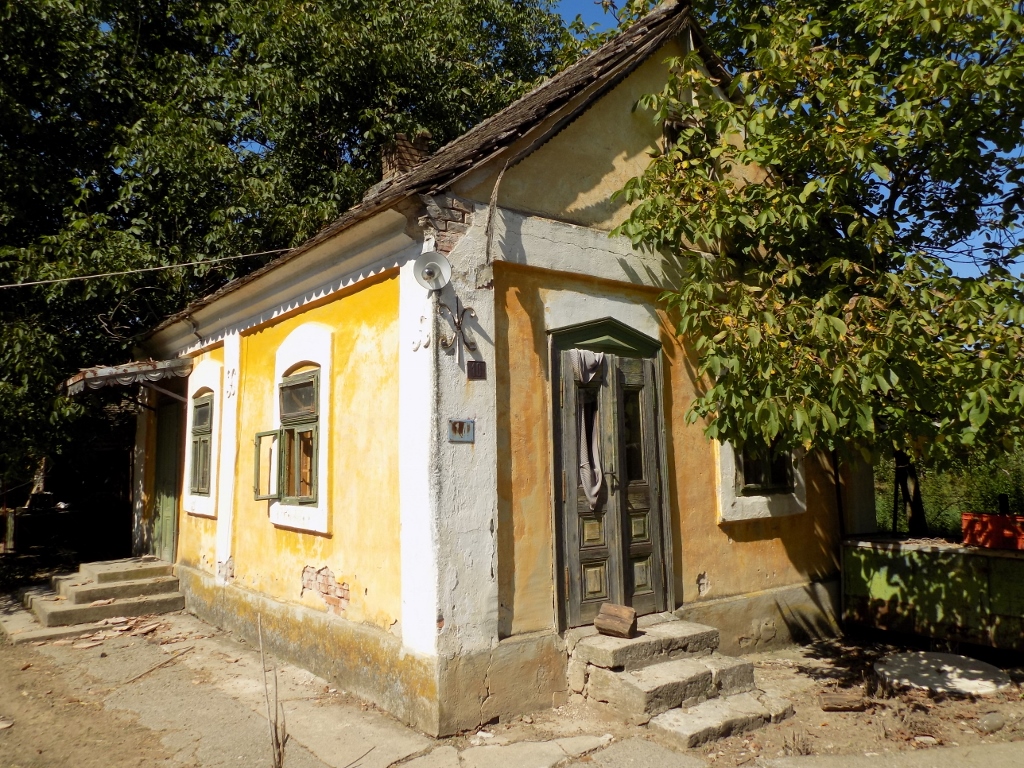 An unknown house beside the road
An unknown house beside the road
This house was certainly of a more recent date, although it appeared abandoned, but the bright yellow colour of its facade probably made it look prettier than it realistically was.
Be as it may, we were supposed to find a tombstone in village Veliki Borak, but again I did not have any clue as to where it exactly was. Along the way I asked a man and he sent us to the centre of the village.
To start with, it needs to be said that in the past the village used to be called simply Borak, but “Veliki” (meaning Great) was added later on account of the great men and great events from the period of the First Serbian Uprising (against the Ottomans) (1804-1813) linked to this village close to Belgrade. I’ll say more about the great men soon, but as for the great events, in 1805 the first National Assembly of the rebelling Serbia was organised here and they also established the Governing State Council (practically the government). Also, during the First Serbian Uprising, the first post-office in Serbia operated right here.
When Svetlana and I got to the centre, first I parked the car and since we saw a café, we headed directly there and sat down in order to get some refreshments. I joked a little with a young man working as a waiter, also asking him where the monument of culture we were looking for was, but he didn’t know and neither did the other guests at the café. However, as it turned out, the man who had sent us here was not completely wrong, since in the very centre of Veliki Borak there is a monument to Prince Sima Marković.
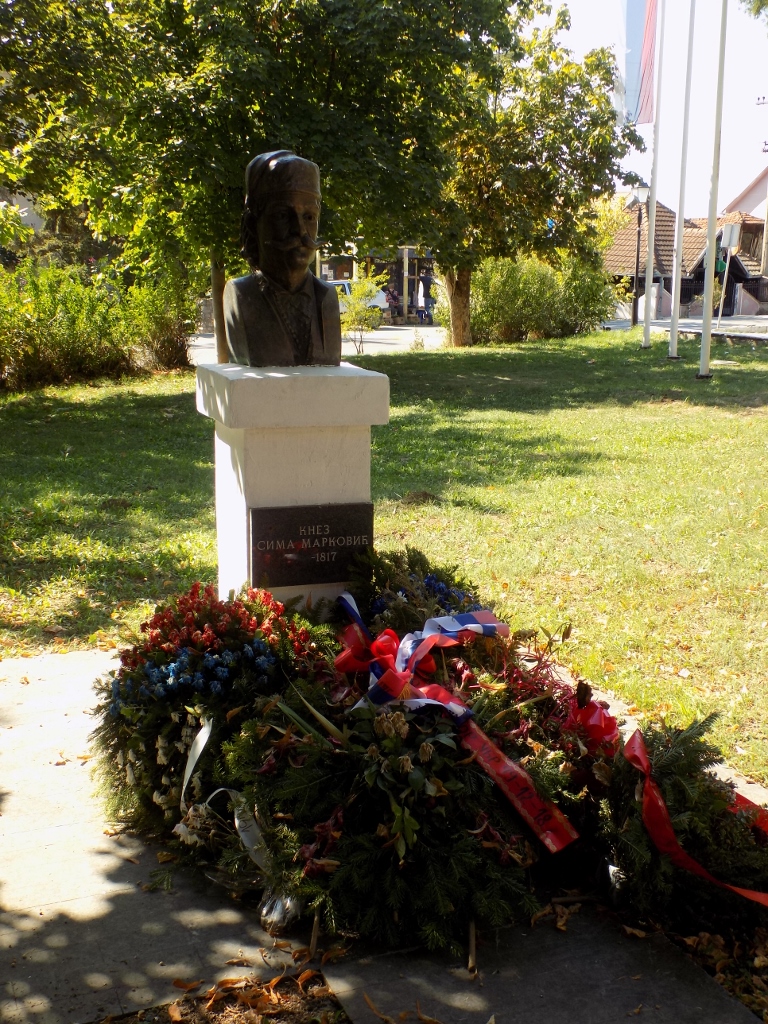 Monument to Prince Sima Marković in Veliki Borak
Monument to Prince Sima Marković in Veliki Borak
Prince Sima Marković was born in this village in 1768 and, among other things, he became famous during the First Serbian Uprising, plus he was the first Minister of Finance in 1811. It was right during the First Serbian Uprising that the army led by Sima Marković was the first to enter Belgrade when liberating it from the Ottomans in 1806. Since in 1817 he led an uprising against Prince Miloš Obrenović, which was crushed, Prince Sima Marković was caught and executed in Kalemegdan (Belgrade) that same year.
But, this was not the monument we were looking for. Having returned to the café where I continued to sip my soft drink, I saw two farmers talking in the street – one was in his tractor, while the other one was standing beside him. It dawned on me – they are local and they should know. So, I went to them, apologised for interrupting and asked them if they knew where the tombstone of Milisav Čamdžija was. The man standing said: “I know. That’s right near me.” He proposed we left in 5 minutes, but I said my cousin was still enjoying her coffee, so he said we would leave in 15, which was enough for him to take a beer.
And so it all happened. He was driving his car in front of us and we followed. Admittedly, he did not finish his beer, but he took the bottle with him, so I presumed he finished it later at his home. To start with, very kindly he slowed down at a crossroad and waved to us through his window in order to show us where we should turn when we continued with our trip later on. Then we followed him further and I don’t think we would have ever found this place, had we not been so lucky to come across this man.
Now let me first say that Milisav Čamdžija (Milisav the Boatman) was born in this village. The exact year is not known, but it was certainly in the second half of the 18th century. He owes his nickname to the fact that he transported people across the Sava river, although there is also a story that after the Austro-Turkish war (1787-1791) he used a barge to transport Serbs across the Sava to Austria in order for them to flee the revenge of the Ottomans. Irrespective of the origin of his nickname, Milisav was known to be a great hero and from the beginning of the First Serbian Uprising he fought alongside Prince Sima Marković. Moreover, as he pledged, during the liberation of the capital in 1806, Milisav Čamdžija was the first one to enter Belgrade. He was also well known for his singing capabilities, so as soon as he got to the ramparts he started to sing out loud and call for his fellow combatant to keep on fighting. It is even said that his song was heard by another famous hero Vasa Čarapić who was mortally wounded in that battle (see: https://www.svudapodji.com/en/belgrade-21/), as well as Karađorđe (the leader of the uprising), and that they both knew who was singing so nicely encouraging the fighters to press on.
The First Serbian Uprising was crushed in 1813, but the Second one started in 1815 and Milisav Čamdžija who apparently loved to fight the Turks joined Prince Miloš Obrenović right away. Milisav was wounded that same year and soon he died. According to his wish he was buried in his orchard under a walnut tree, next to his brother Ivanko. A headstone was placed there and this was precisely the monument of culture we were looking for.
So, as I’ve said, there is no way I would have found out where exactly this was, had I not come across this wonderfully kind man, for I’m sure that the two headstones cannot be discerned from the road. This way, Svetlana and I, led by our host, entered a plot that seemed rather barren and from there we moved to the adjacent plot and there on the top of a mild slope in the middle of a grove there were these two tombstones.
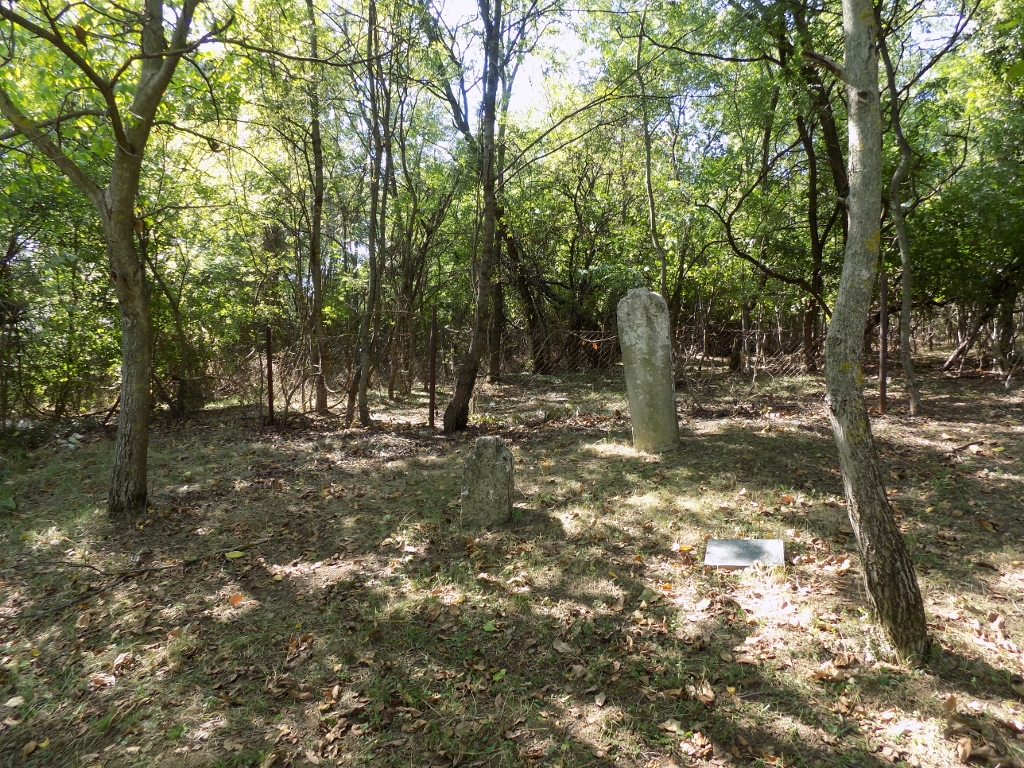 Tombstones to Milisav Čamdžija and his brother Ivanko
Tombstones to Milisav Čamdžija and his brother Ivanko
Admittedly, perhaps one might notice a while flagpole that is used when a delegation comes here. As our host told us, the army delegation comes, I guess, once a year and as for the other officials, only one president has ever visited the site (President Koštunica).
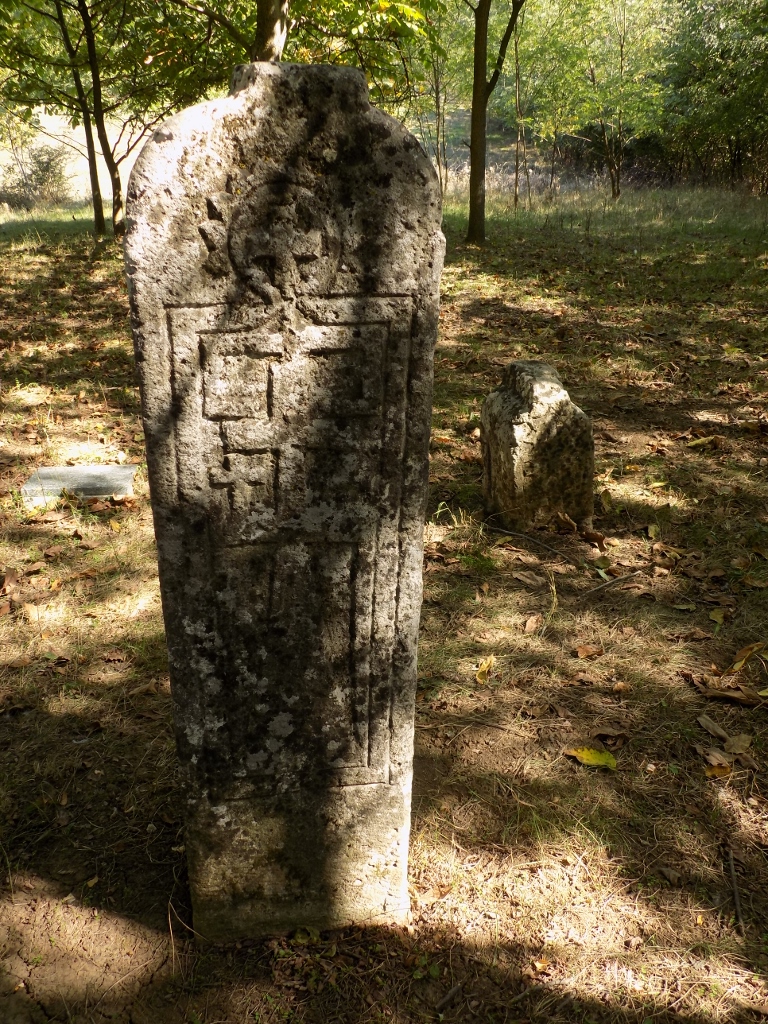 Tombstones to Milisav Čamdžija and his brother Ivanko (the road is down at the bottom of the slope)
Tombstones to Milisav Čamdžija and his brother Ivanko (the road is down at the bottom of the slope)
Although he was famous for being a great hero, Milisav Čamdžija was also a modest man who was not interested in medals or titles and all he wanted was to be buried in his plot of land. His wish was granted.
After the short visit to the monument, we all got down to the car and our host even invited us for a coffee. We thanked him, but apologised because we had to move on. Exceptionally happy because of the lucky set of circumstances and the visit to this unusual place, I continued to drive in line with the previously envisaged plan. We turned right at the point where our host had shown to us earlier and soon we came across a road sign pointing where one should turn off the main road in order to get to the natural monument “Tri hrasta lužnjaka” (Three Common Oaks) that is located on the territory of village Šiljakovac.
There is also a grassy clearing by the road here where we left the car and following a path we got to the oaks. Along the way, in a couple of places, we saw some rather big mushrooms that looked like porcini from the top to us, but as neither of us knows anything about mushrooms, we did not touch them. On the other hand, their stipes did not look like the porcini’s, which only inspired us even more not to touch them at all.
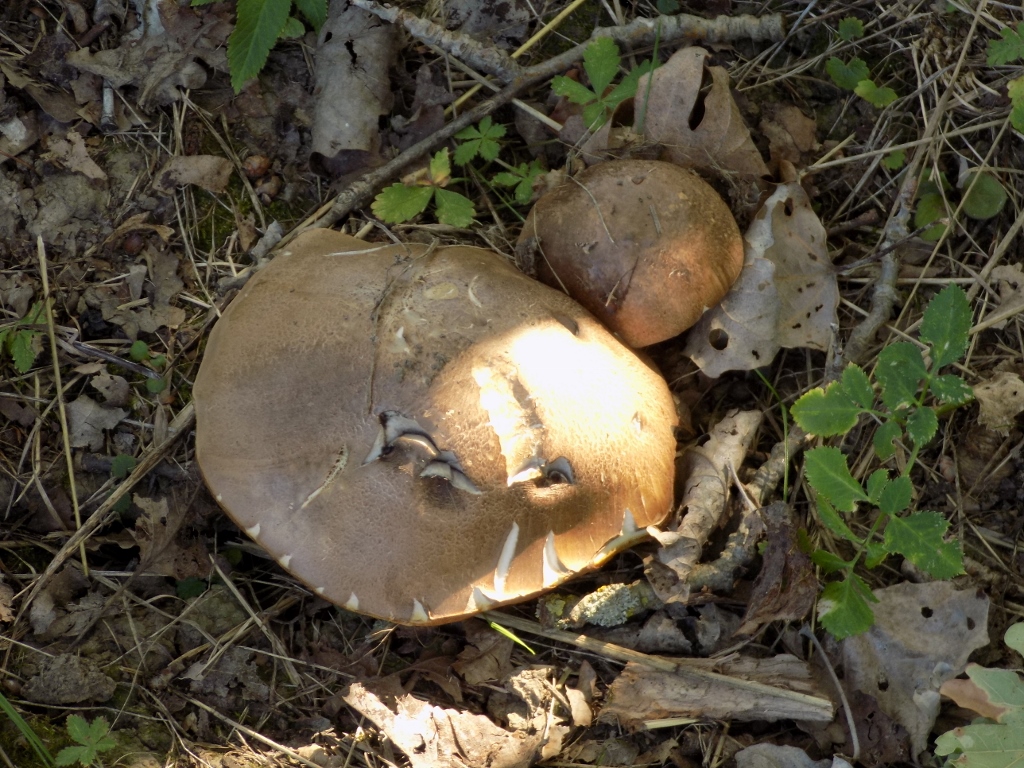 Mushrooms in nature
Mushrooms in nature
Although the natural monument is called “Three Common Oaks,” nowadays only two of them can be seen, since the third one withered and died in the meantime. Still, as soon as you come closer you can see that the oaks are taken care of, so the branches are supported since otherwise they would break on account of their weight.
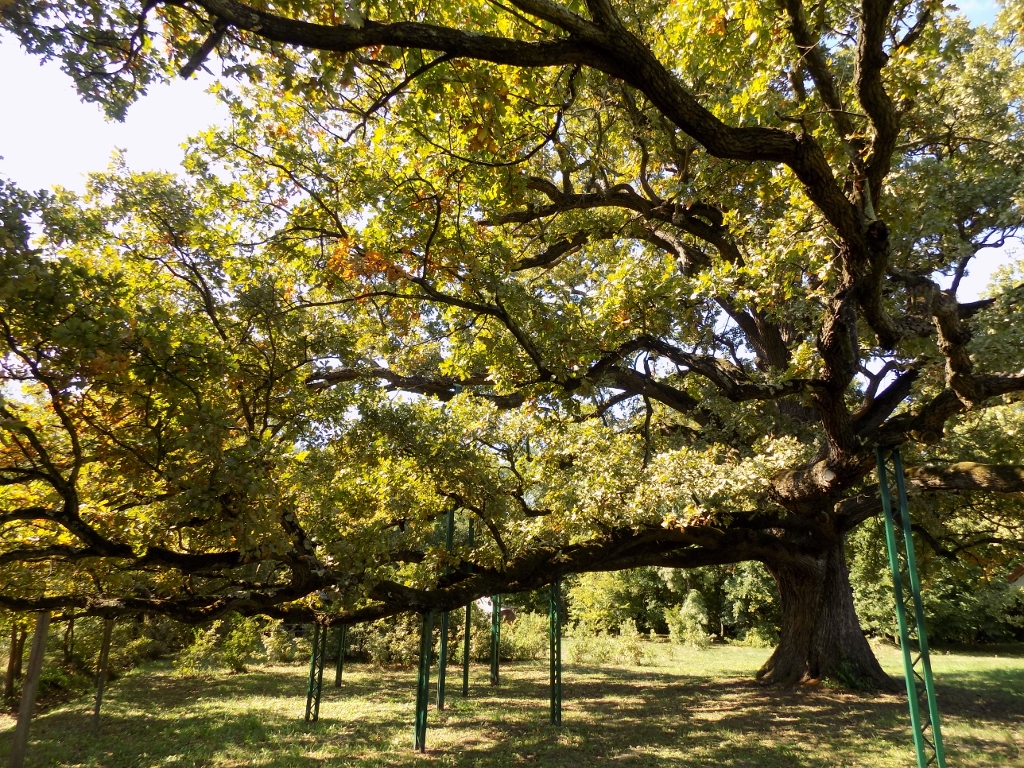 One of the oaks within Tri hrasta lužnjaka natural monument
One of the oaks within Tri hrasta lužnjaka natural monument
In the past, Serbia used to have a large number of oak forests. After all, the name for Šumadija, the central region in Serbia comes from word “šuma” (forest). As the information board that exists here says, the common oak (Quercus robur) “deserves the title of our most valuable broad-leaf tree species” and it may reach the oldest age among the European trees (up to 1000 years), as well as a very impressive size. The information board also provides data for all three oaks, but I must admit I was not certain which one of the three had died. In any case, the data about them is impressive – the age goes from 150 to 220 years, the height goes from 23 to 25 metres, while the width of the top goes from 20 to 34 metres.
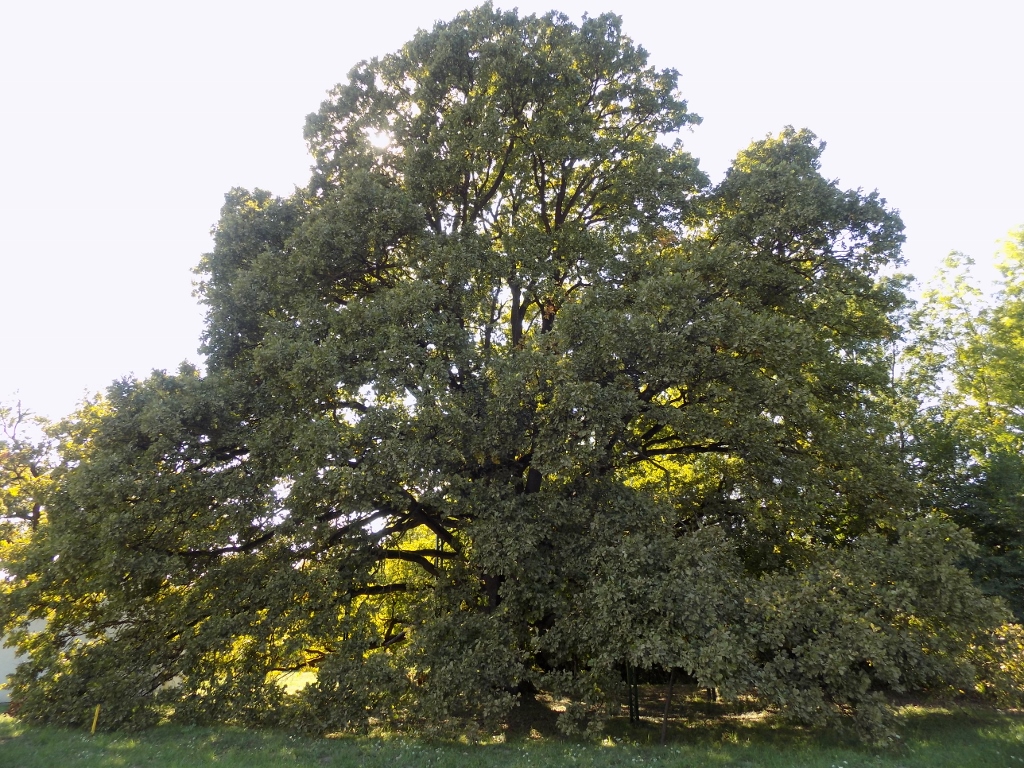 One of the oaks within natural monument Tri hrasta lužnjaka natural monument
One of the oaks within natural monument Tri hrasta lužnjaka natural monument
Still, even that third one that had died has not disappeared completely from the site, but rather one of its parts is exhibited on a concrete platform. It may be seen as soon as one approaches the first oak.
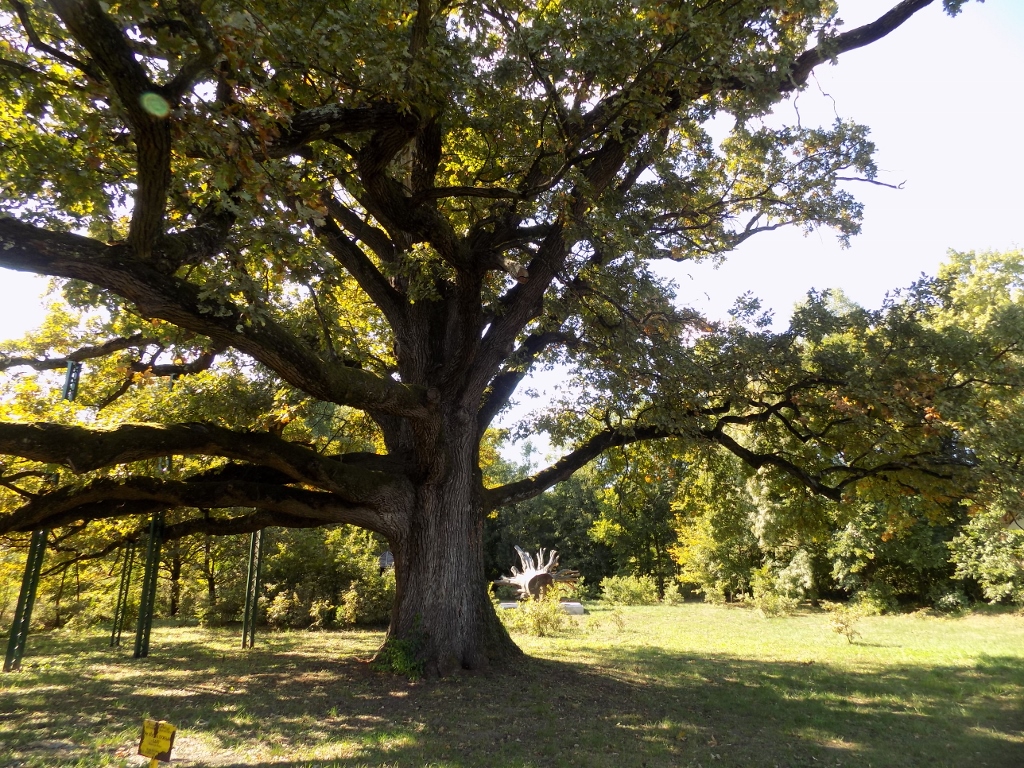 One living and one dead oak
One living and one dead oak
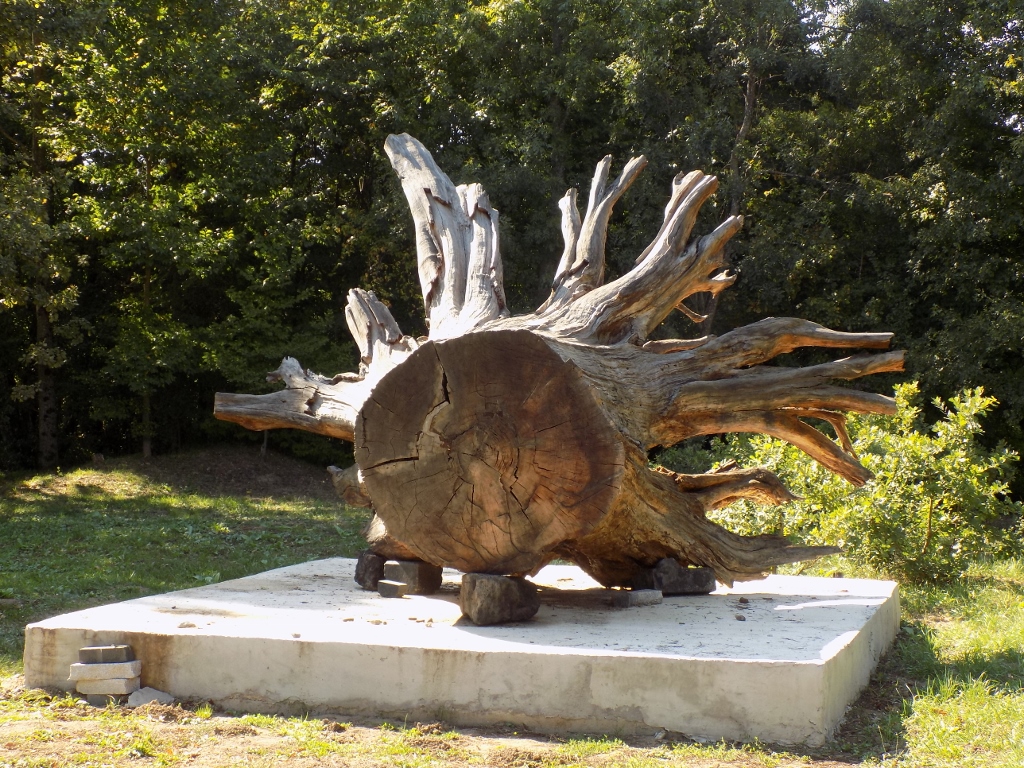 Remains of the dead oak
Remains of the dead oak
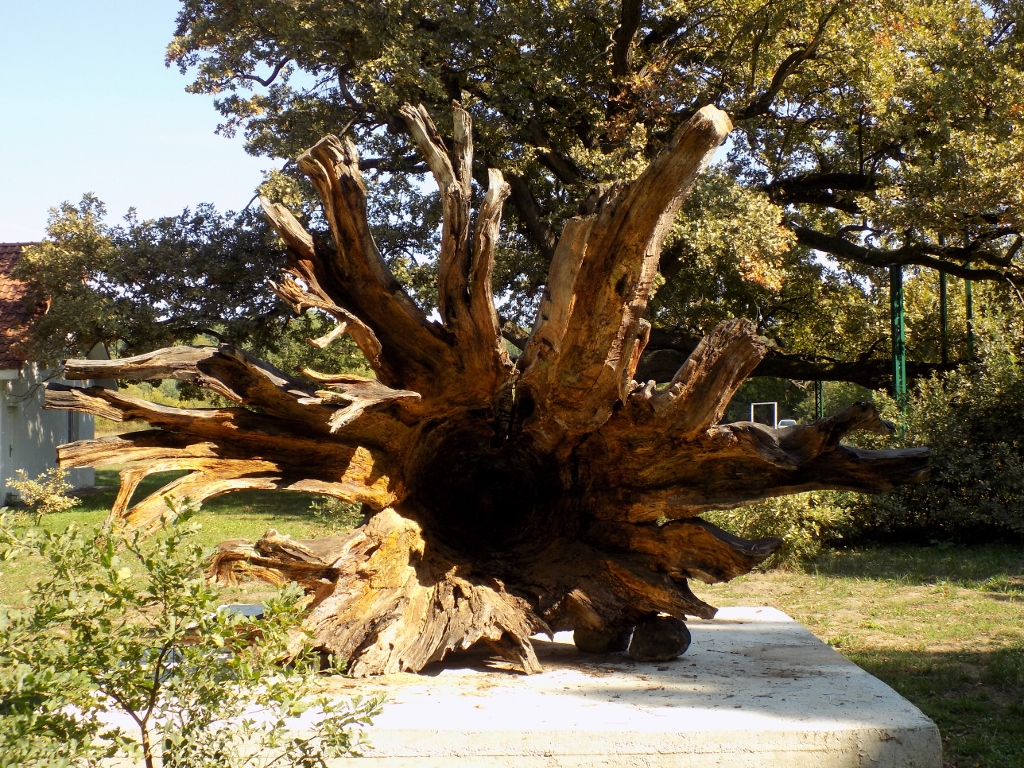 Remains of the dead oak
Remains of the dead oak
When I made a full circle around the site, I noticed in one place some “chicken,” but it was clear to me that these were not real chicken, so I looked a little better. As it turned out, we stumbled across a whole bouquet of pheasants – females and young males, and we counted as many as 16 of them! Still, they were not very cooperative and they refused to pose, while we did not want to chase them for we would only frighten them. Although not all of the photographs are good, I included them into this story in order to illustrate the beauty of their feathers.
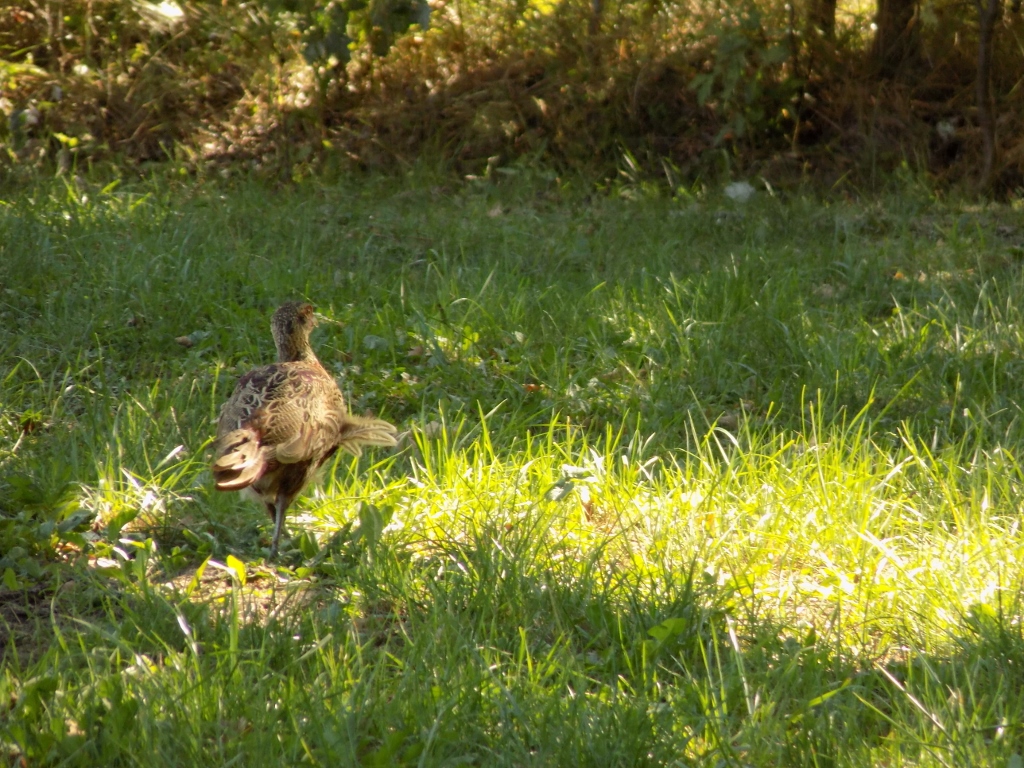
This is how it all started – a lonely specimen walking in the grass
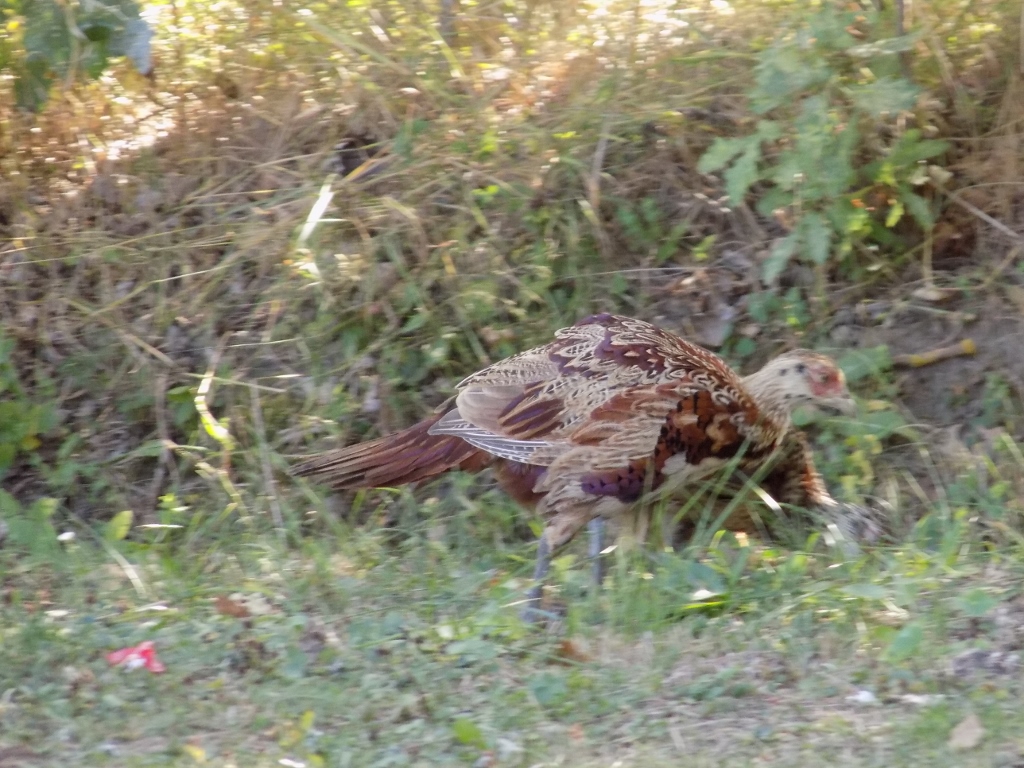 Then other pheasants started to arrive
Then other pheasants started to arrive
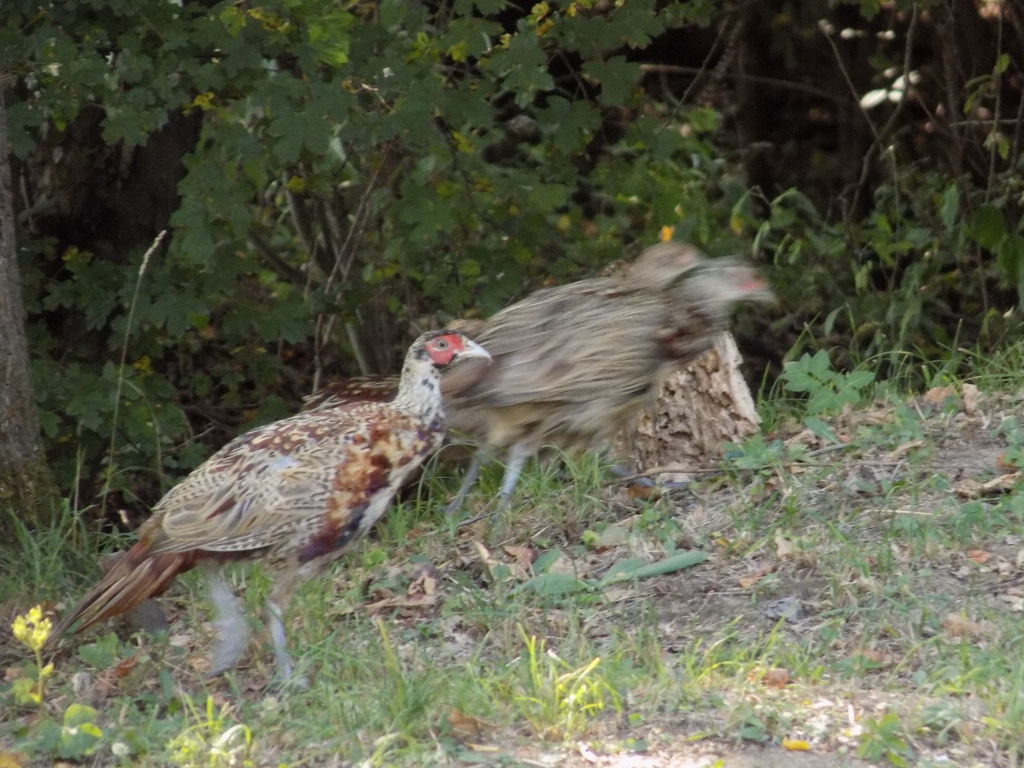 Some stop seemingly confused, while others continue to move on
Some stop seemingly confused, while others continue to move on
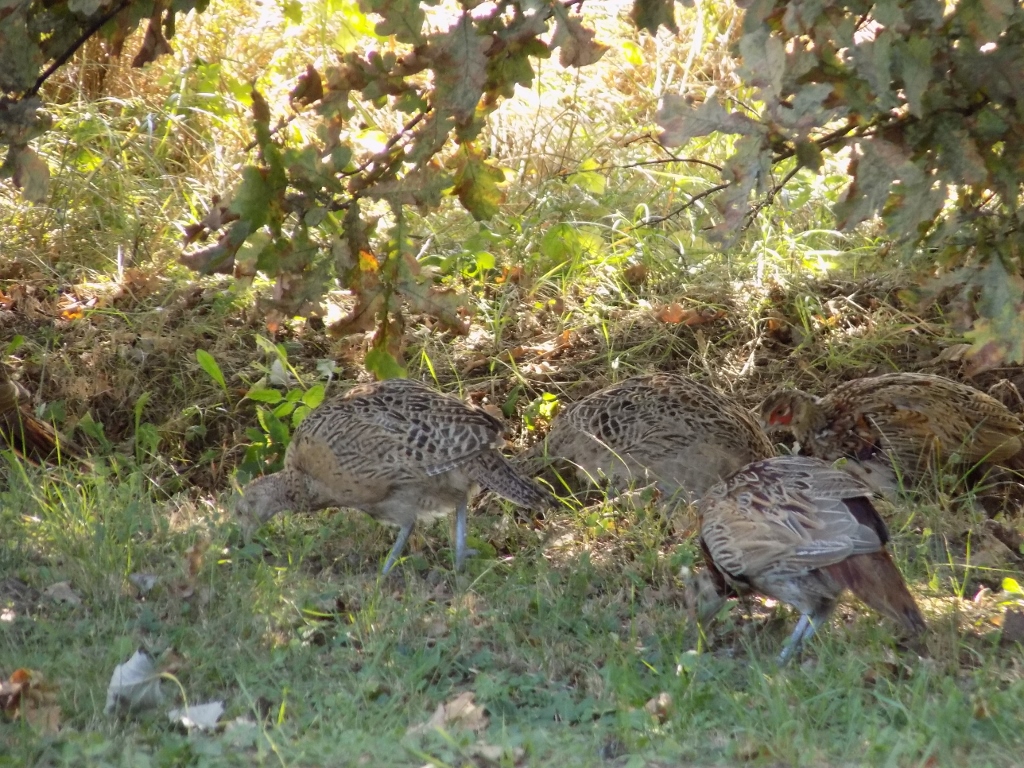 There were many of them
There were many of them
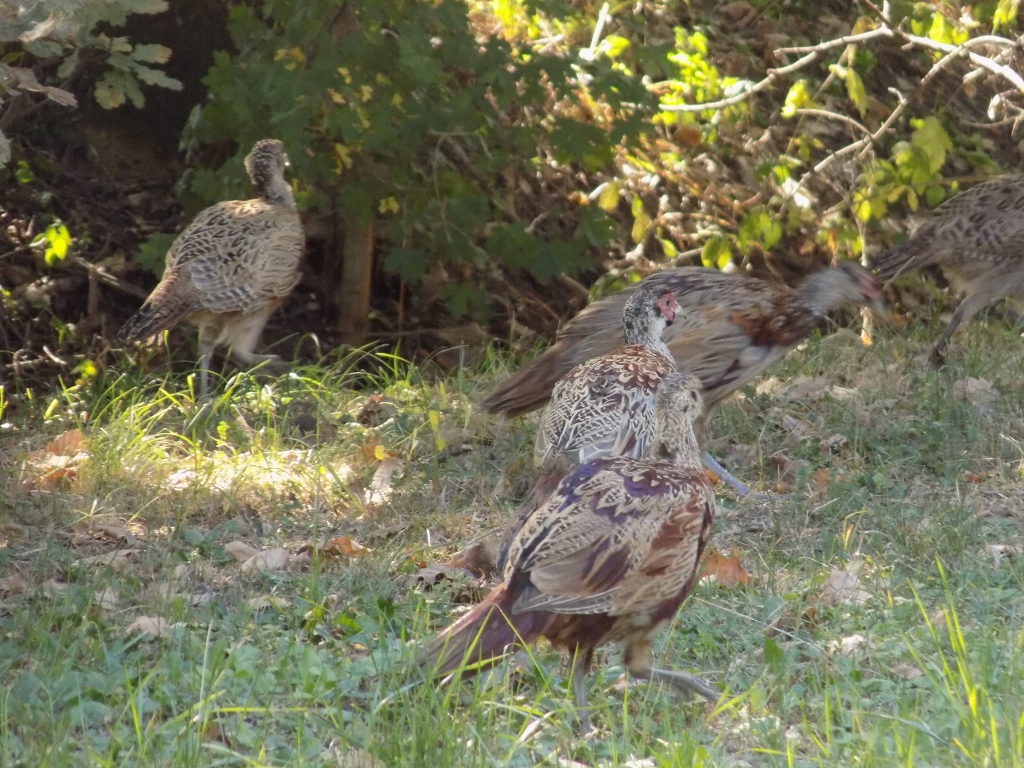 And then they started to leave us
And then they started to leave us
Very content that at this natural monument, in addition to the oaks, we also saw mushrooms and numerous pheasants, we got into the car again and continued towards the centre of the village on the territory of which we already were and this was Šiljakovac.
There are two old houses here which are both monuments of culture. They are situated at two neighbouring plots separated by the main road. The house of the Stevanović family is on the right-hand side when coming from the direction of “Tri hrasta lužnjaka” and although there was nobody at the plot where the house was, we could see that it was easy to enter, so we did in order to get closer to the house that could also be seen from the road.
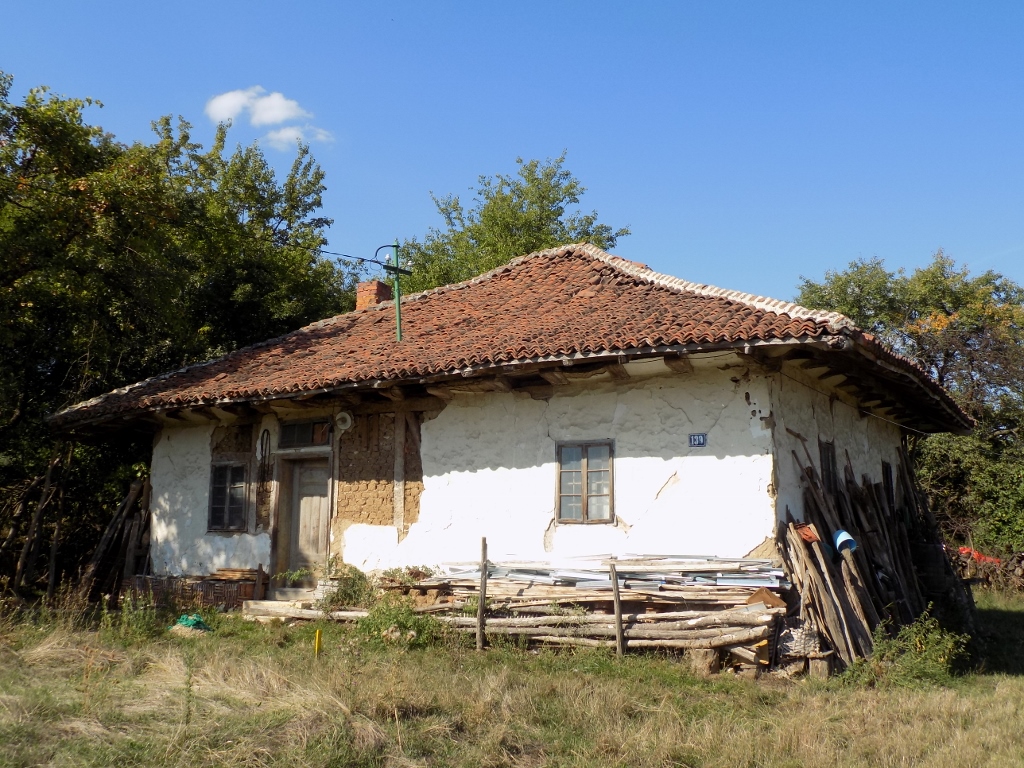 House of the Stevanović family in Šiljakovac
House of the Stevanović family in Šiljakovac
The house was built around the middle of the 19th century and it constitutes a good example of the houses built in this period by wealthy Serbian families. The foundations are made of broken stone, while the house is a half-timber structure with doub infill. Mud mortar was applied over the structure which was then whitewashed. This house, like a large number of houses built in this period, is characterised by the pronouncedly extended eaves.
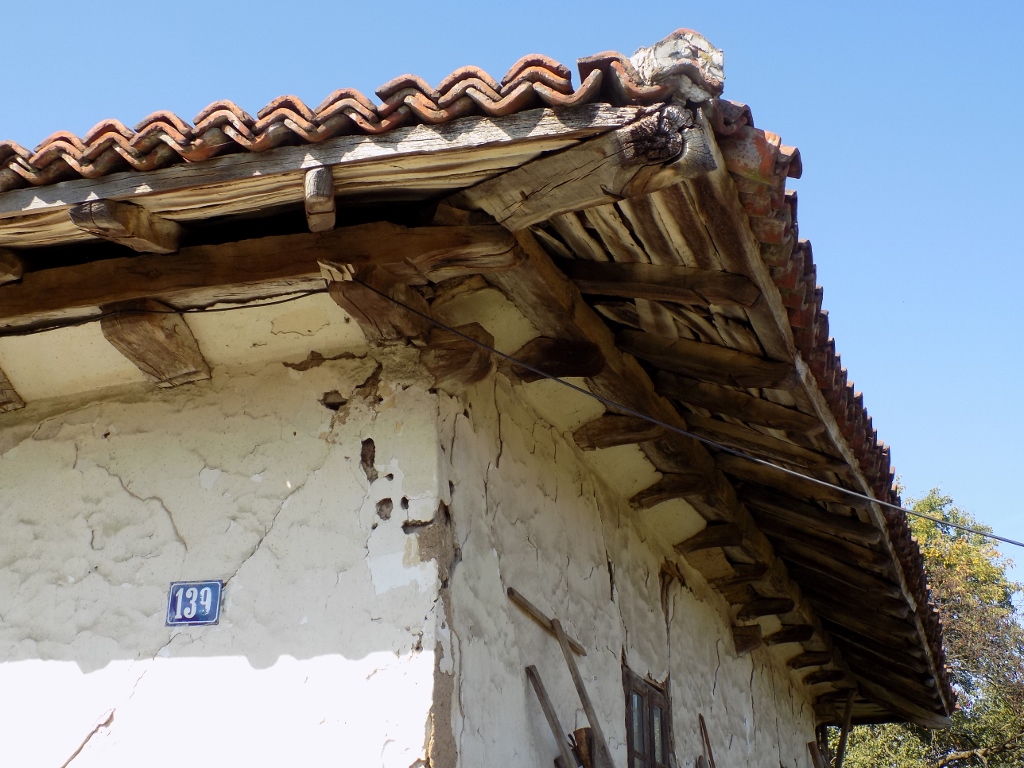 Eaves of the house of the Stevanović family in Šiljakovac
Eaves of the house of the Stevanović family in Šiljakovac
In addition to being able to see the house from the outside, we could see that somebody actually lived in another house on the same plot, but there was nobody there at the time whom we could ask anything. So, we just went to the back of the house as well and that was it.
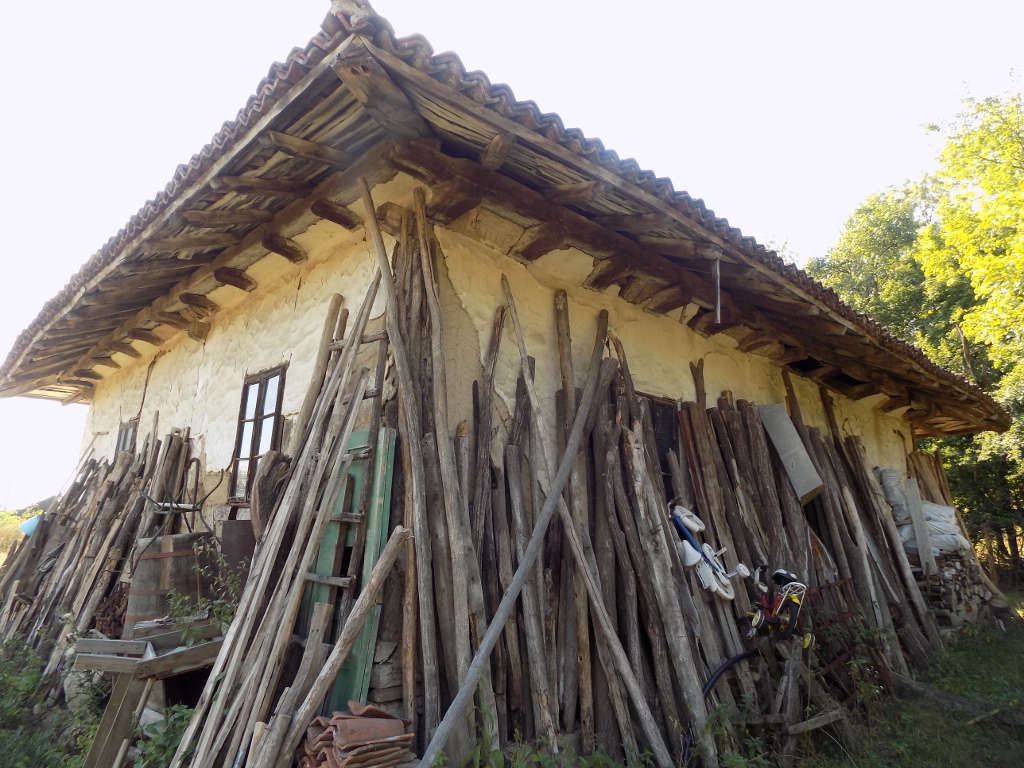
Back of the house of the Stevanović family in Šiljakovac
As far as the house of the Jeftić family is concerned, which was most probably built between 1830 and 1840, it is situated on the plot of a certain Todorović family (as far as I could figure). Before this trip, I read that the current owners complained that visitors entered their property without a word in order to get to the house and I had all the intention of asking for a permit before doing so. Still, we could not see anybody in the property and the fence was quite clearly locked up, so in the end we did not succeed in seeing this house.
So, we just got into the car and drove to Ibarska magistrala road and then to the turning point to village Vranić. According to the map there is a shortcut, but back in the day I was taught by one of my bosses that the shortest route is the route you know. Guided by this good advice, I drove Svetlana and myself to the yard of the Church of St. Elijah in Vranić where in addition to this church there is also a 19th century wooden church that is a cultural property of great importance. I was already here in November 2019 and I have already written about it (https://www.svudapodji.com/en/south-of-belgrade/). Still, I was interested to see what was happening with this wooden church, plus it was nice to see it all again in the wonderful late summer sunlight.
To start with, I paid a little more attention to the Church of St. Elijah which was built at the end of the 19th century and was consecrated in 1888.
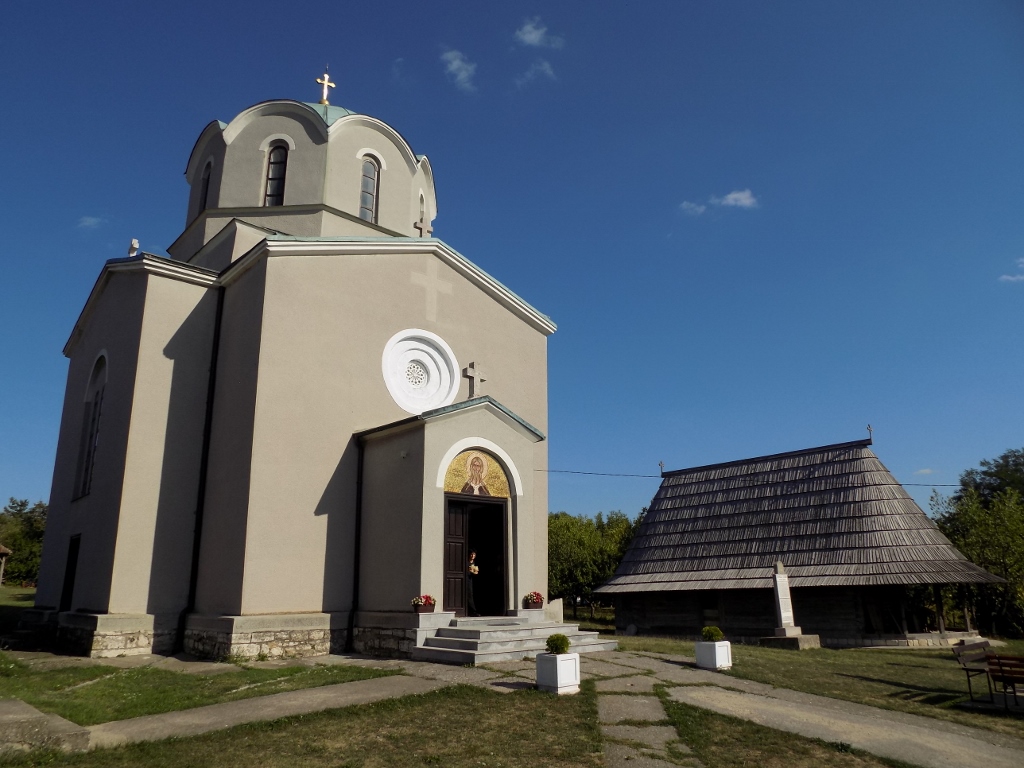 Church of St. Elijah in Vranić (left), while the wooden church is to the right
Church of St. Elijah in Vranić (left), while the wooden church is to the right
The Church of St. Elijah has a compact cross-in-square plan and particularly visible is its dome that is octagonal from the outside and semi-spherical from the inside. The interior of the church is very nicely decorated.
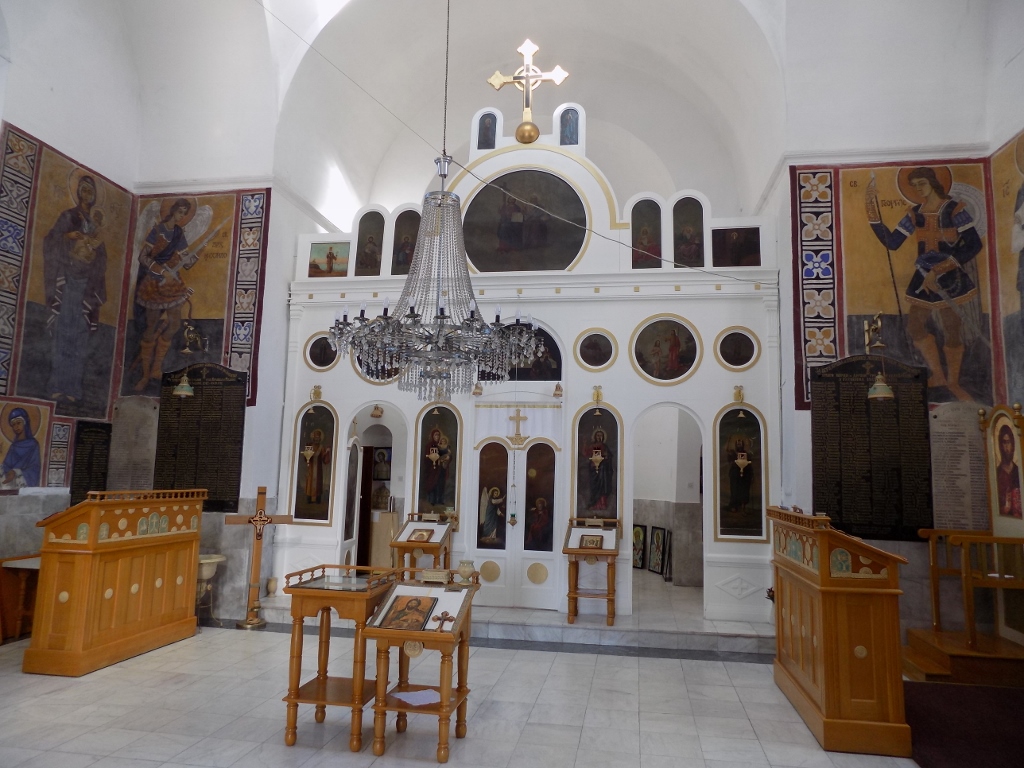 Interior of the Church of St. Elijah in Vranić
Interior of the Church of St. Elijah in Vranić
As for the 1823 wooden church in Vranić, I’m not going to repeat its data now, for I have already written about it. Still, the photos are different this time around since it was still day and the Sun was shining.
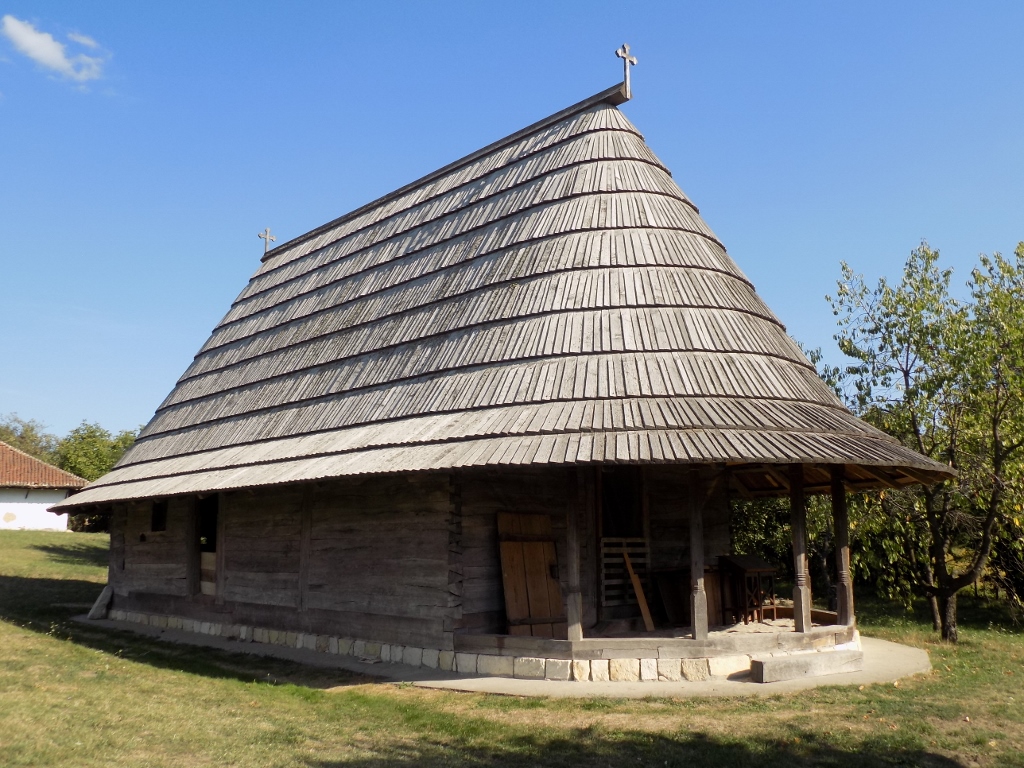 Wooden church in Vranić
Wooden church in Vranić
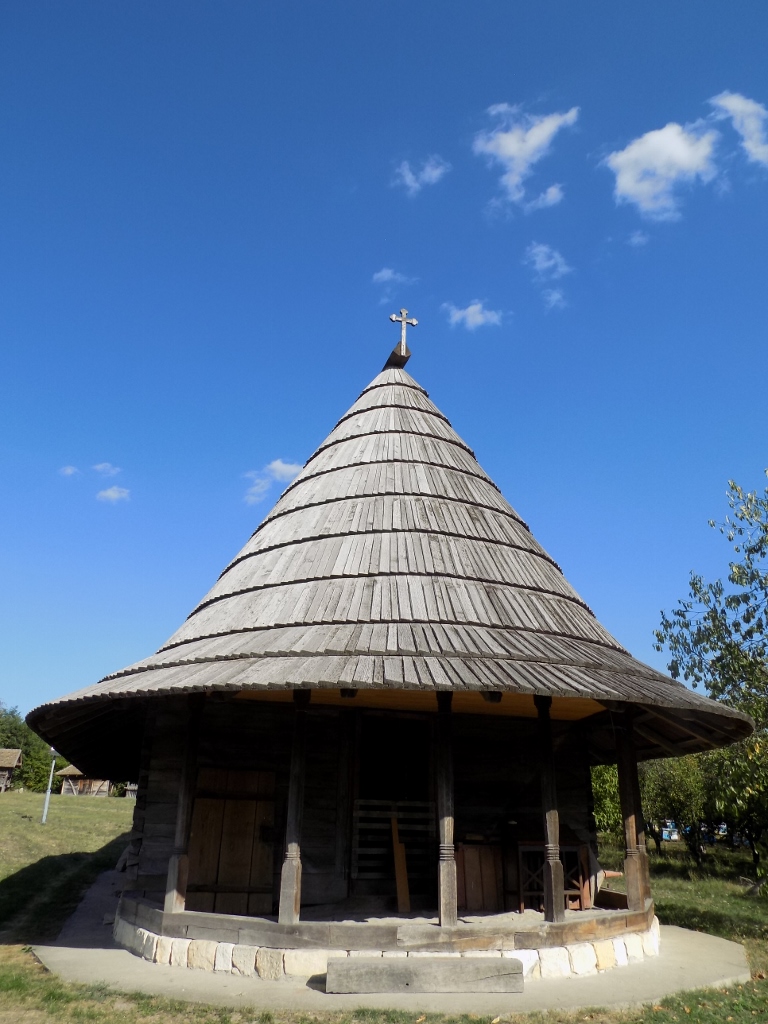 Wooden church in Vranić
Wooden church in Vranić
Two years ago this church was closed since it was obviously due to be renovated and I can report that the situation remains the same now. Still, in order not to make it all too negative, I could see that some works are taking place inside and so I hope that the next time I come here it will be completely restored.
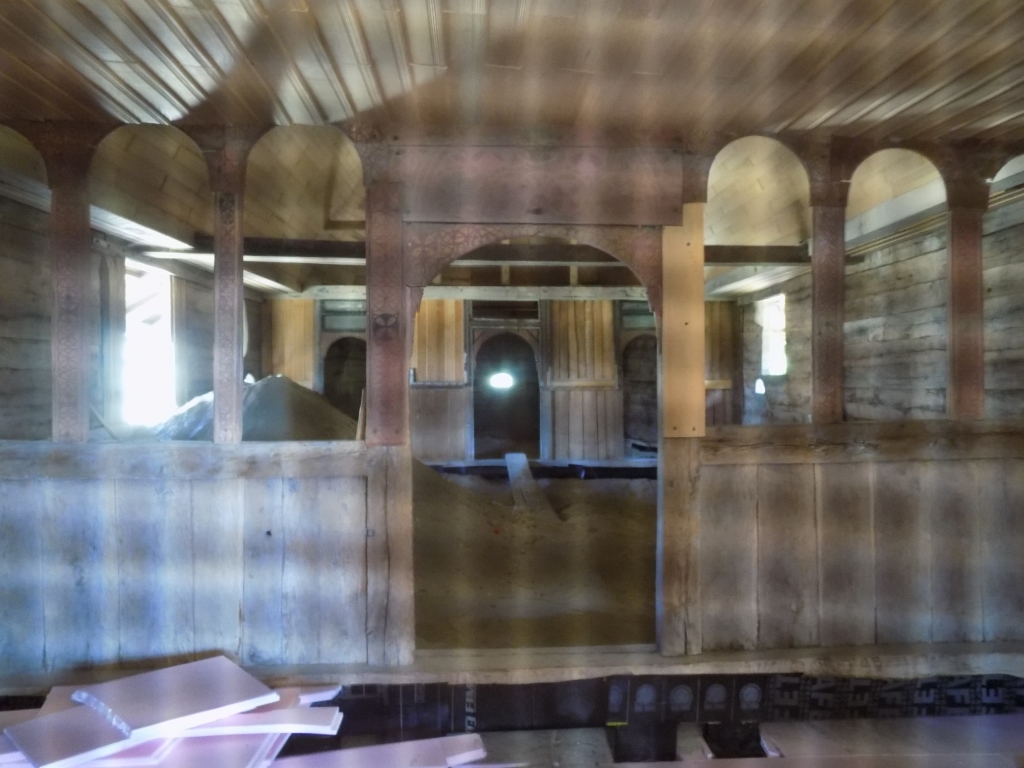 Wooden church in Vranić, the interior seen through a protective dense net
Wooden church in Vranić, the interior seen through a protective dense net
Within the churchyard there are also several structures of vernacular architecture with the house of the Matić family standing out in particular. The house was transferred here around the middle of the 20th century in order to be saved from demolition. I have also commented on this in the travelogue about the 2019 visit. This is an absolutely splendid example of preserving our heritage, unlike some other monuments seen during this trip. It also confirms that where there is a will there is a way.
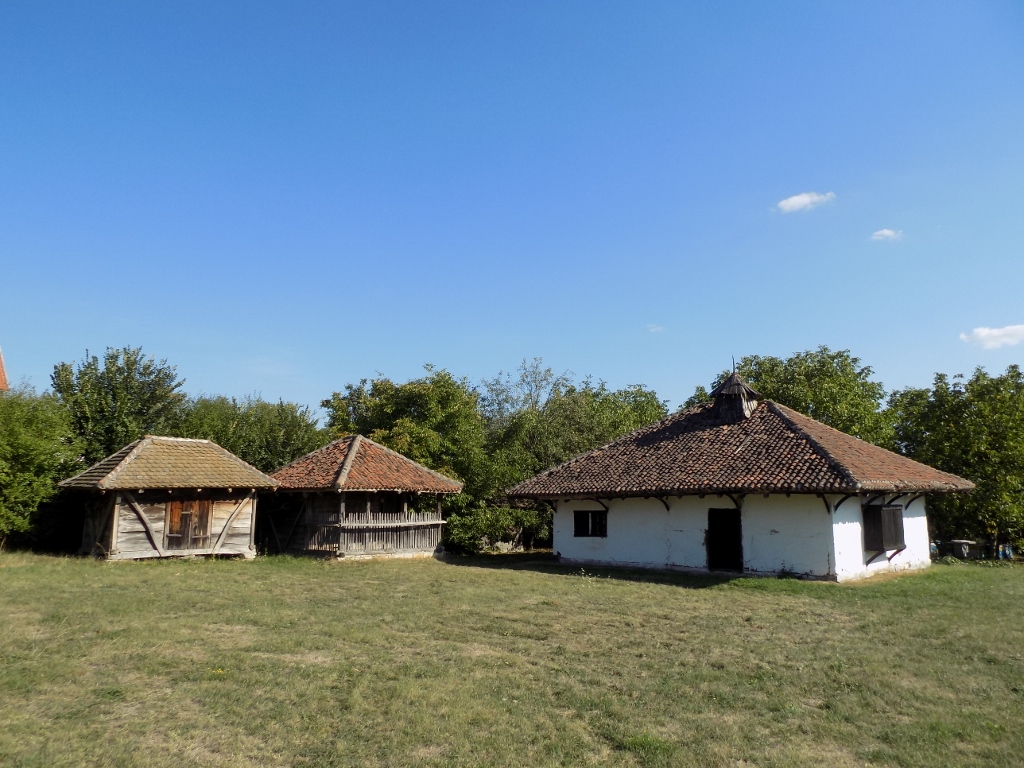 House of the Matić family (right) and a couple of other picturesque structures of vernacular architecture
House of the Matić family (right) and a couple of other picturesque structures of vernacular architecture
The churchyard in Vranić also contains several tombstones and Svetlana noticed a particularly interesting one from 1857, drawing my attention to it. The text says that a certain Nikola died of plague in 1814, while his parents died somewhat later (in 1818 and 1829). When putting the family tragedy aside, the text is rather standard, but I found the script and the word for “passed” used here rather interesting. Unfortunately, this cannot be translated, at least not in a few words.
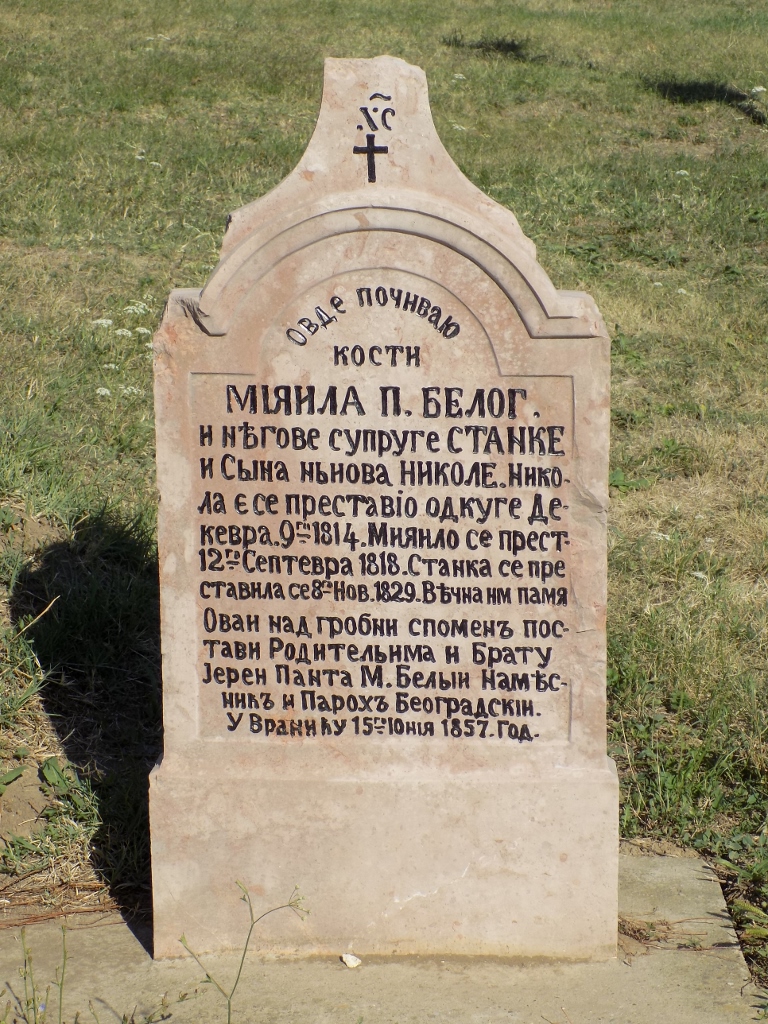 A tombstone from the churchyard in Vranić
A tombstone from the churchyard in Vranić
The only thing left for the two of us to do was to go to the old primary school in Vranić which is a monument of culture. It was built at the beginning of the 20th century, very close to the place where the older primary school from 1848 used to be.
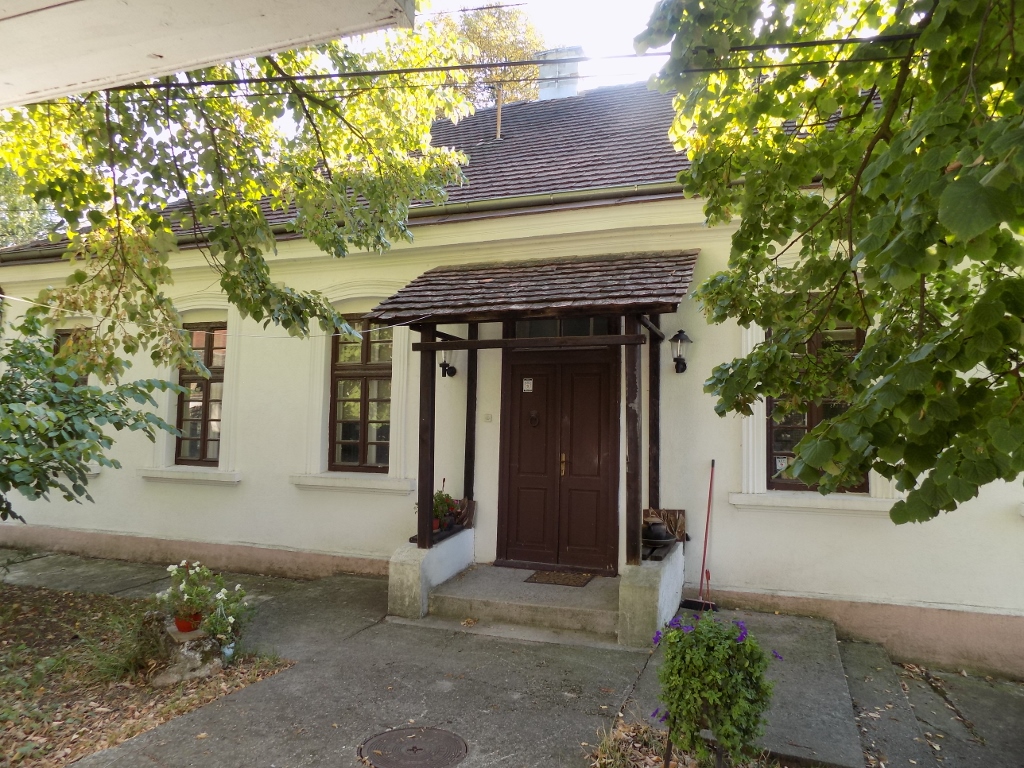 Old primary school in Vranić
Old primary school in Vranić
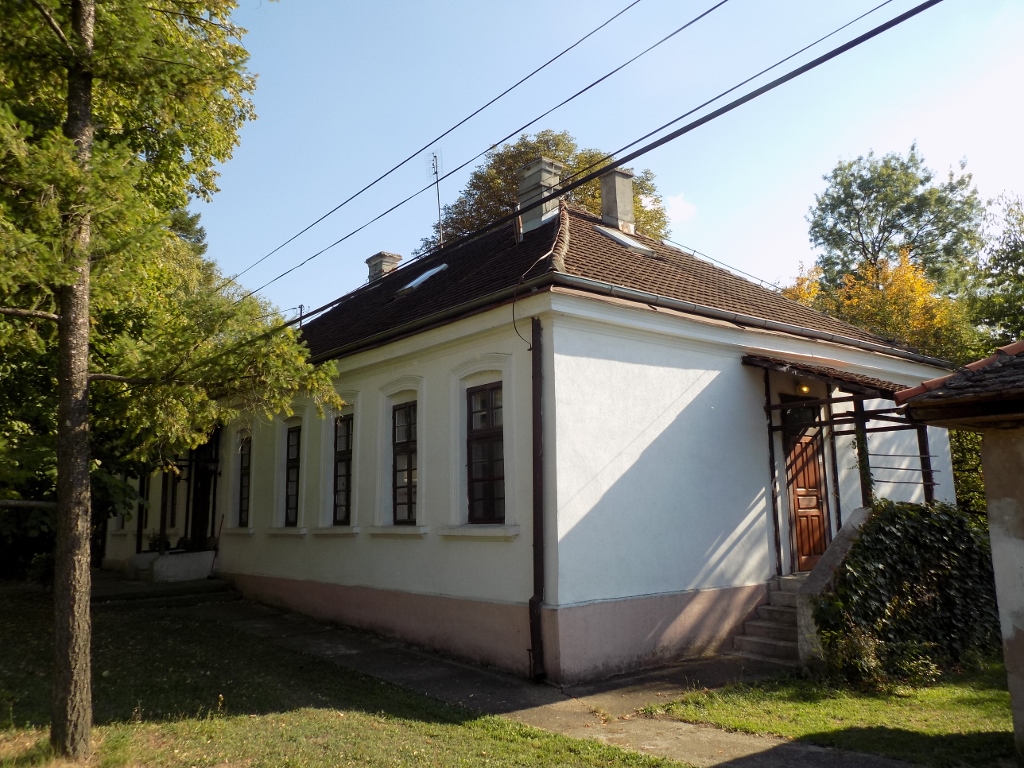 Old primary school in Vranić
Old primary school in Vranić
The data says that the school was built in the centre of the village, but this was the old centre, while the present-day centre of Vranić is elsewhere. Although I could not fathom the current function of the structure, it could be seen that the building was in a good state and that it was kept well.
So, here we completed our sightseeing tour and thus we got back into the car and returned to Belgrade. Still, since it was such a glorious sunny day, before heading back home, we went for a late lunch at Ada Ciganlija (a leisure area by a large artificial lake) and some more relaxing, which wrapped up a fabulous day.
Here is once again the map showing where we went to.